LSR Black Hole 2-1's
Quiet Touring 2-1 Performance Exhaust
Bonneville, Dyno, & Track
Proven Since 1978:
No Stupid
Megaphones , No Stepped Headers, No Aluminum Butt Plugs
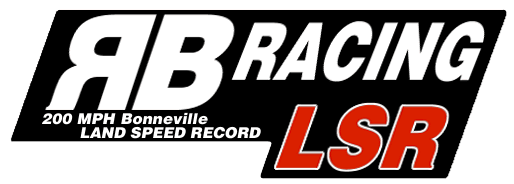
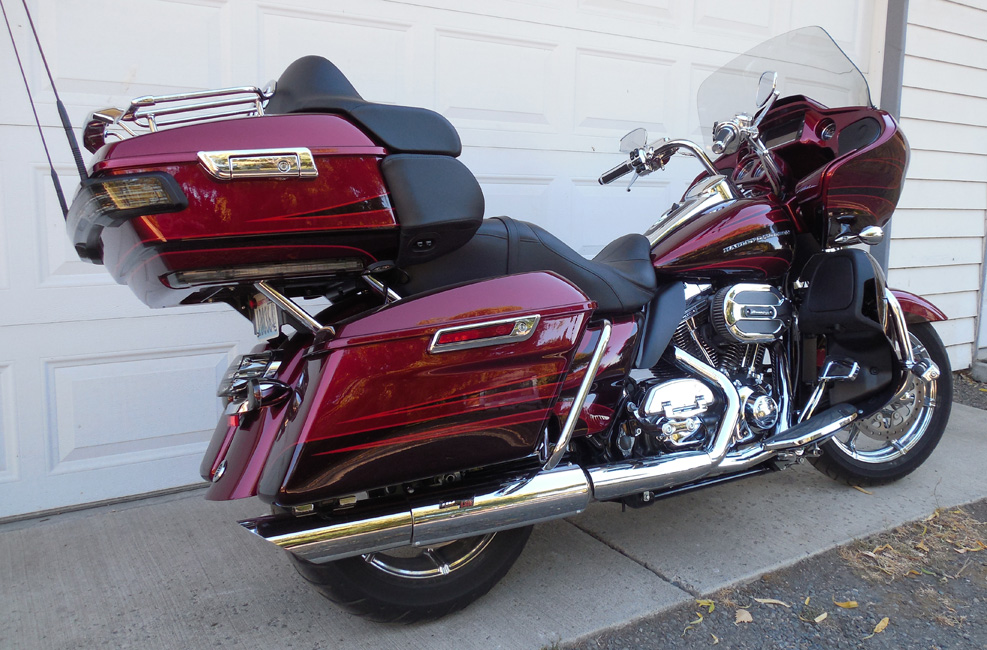
All LSR 2-1 Black Hole designs have a
welded-in, non-removable, 00-1416 baffle. Designed to be
quieter than other Bagger 2-1 designs. No heat issues.
Purchasing the
LSR 2-1Exhaust
1. Go to the Partnumbers Page
to Locate your bike
2. Systems come complete
with
a. Included in price: Look Up Heat Shields
to see what comes with your exhaust: Heat
Shields
b. Included in price: 00-1000 / 00-1001 / 00-1002 Flanges
/ Clips / Nuts
Three LSR 2-1 Finishes
1. Show Chrome:
The brightest chrome, the "Hexavalent" process, has been
outlawed in California since January 2024. Chemicals in
the Hexavalent process can be cancerous to chrome shop
operators, not the end consumer. The currently legal "Trivalent" chroming
process has a darker hue and does not visually "pop".
Our chrome shop of 26
years finally shut down their Hexavalent plating line in
2024 in spite of having a two year extension to operate.
We are working with a new chrome plater, in
business for many decades, who still uses the Hexavalent
Show Chrome process and understands motorcycle exhausts.
All LSR 2-1 Exhausts and
heat shields are mirror polished and plated with
Hexavalent Show Chrome.
2. Silver Ceramic:
Looks like polished aluminum, Can be re-buffed with
Mothers Magnesium & Aluminum Polish. Will not "Blue"
and will not come off or rust. Holds in heat. Usually used
with chrome or silver heat shields. Fired twice @ 600F.
Zero problems in more than a decade. Not internally coated
and no internal media contamination as exhausts are sealed
during the process.
3. Dual Coat Black Ceramic: Silver Ceramic base with secondary coat of Black Ceramic. Fired three times @ 600F. Only black Finish that will hold up. Zero problems in more than a decade. Not internally coated and no internal media contamination as exhausts are sealed during the process.
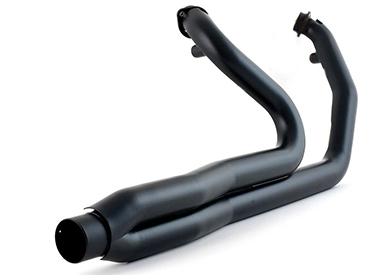
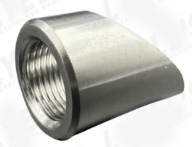
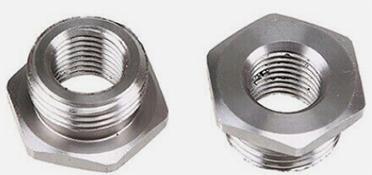
Born Every Minute As They
Say: LSR Black Hole Versus
$3200.00 Black Burns Stainless 2-1
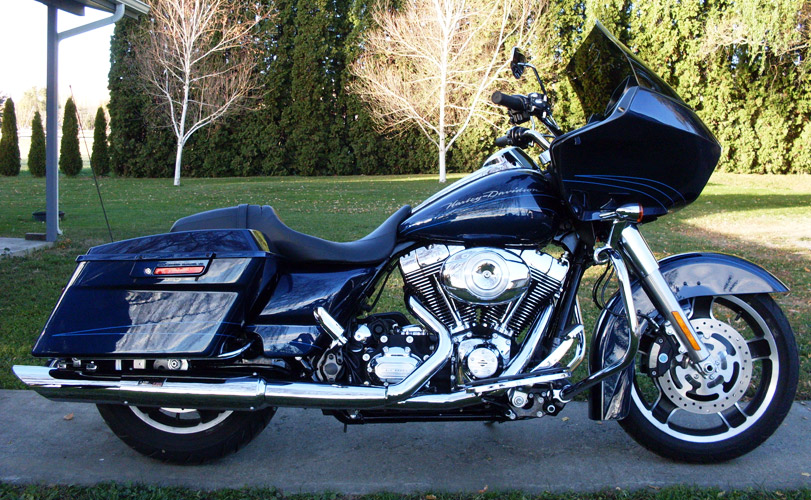
Above: LSR 2-1 Black Hole
Twin Cam with full coverage heat shields. Quiet unrestricted
performance.

You can spend upwards of $3,200.00 for a,
new to the market, Burns Stainless black megaphone 2-1 exhaust
with only a single abbreviated heat shield ($185.00) and no
long term history in terms of pipe mounts or over the road
long term durability. Also
not available in chrome. Whoever chose that bend radius
flunked aesthetics 101.

For about the same money you can get a competition and dyno proven LSR 2-1 Black Hole in dual coat black ceramic, silver ceramic, or full chrome, with full coverage heat shields, a TTS MasterTune, a TTS Camshaft(s) and a RSR Dual Display AFR Gauge for, as you ride, monitoring to perfect your tune. Full 2" primaries, billet gaskets, and CNC machined turbo venturies. No flat gaskets that mush into the port.
We tried
megaphones 30 years ago. They are a waste of time. It's
old tech for Norton Manx's and pukka 1950's English bikes.
There are no megaphones on any race cars...formula, GP,
WRC Rallye, NASCAR...Nowhere. 47 years of this shit. We've
seen it all. Stepped
primary tubes are for clowns.

Customer writes: "Attached are three YouTube Videos of my
2001 Heritage Classic FLSTC/I, with the Pro Stock
Spyder and the new Ceramic Black Hole exhaust. The
Bike is a TC95 Cid with Branch O’Keefe PT heads and
84,500 total miles on it. The original Pro Stock
Spyder was on for 10 years/22,000 miles and it still
looks like new.
This first video was inside my
shop, and the sound is OK until I touch the throttle
when the microphone on the cell phone cuts the sound
back due to the high decibel levels. https://www.youtube.com/watch?v=iskObtU9LUA
This second video was outside to
get a more realistic sound but again when I touch the
throttle the cell phone cuts out some of the sound due
to high noise levels. https://www.youtube.com/watch?v=9uCw2UW2Md0
The third video is after I
installed the Black Hole exhaust Saturday afternoon
and rode the bike Sunday morning for 30 miles. The new
pipe made a significant difference. https://www.youtube.com/watch?v=HDw67ZAIj0Q
My evaluation of the Black Hole
Exhaust with the additional baffling is that it is
significantly better sounding that the Pro Stock
Spyder on a TC95 with 9.8 compression and performance
heads/larger valves. The Black Hole is still has
a nice loud performance exhaust sound with a note that
is deeper and lower even at 75 to 85 on the freeways.
I would recommend this exhaust to anyone. It would be
a perfect first upgrade for any stock bike and the
best exhaust you could have especially if you plan to
start pushing more horsepower and higher compression.
It would be a perfect foundation that all other
performance upgrades could build upon. As always, the
fit and finish is perfect, and the bike looks and
sounds excellent especially considering it’s 24 years
old with 84.500 miles on it.
I believe this Pro Stock Spyder
would be a perfect upgrade for a TC88 or 95 that
hasn’t had significant changes to compression or
radical headwork.
New
Item..Shorter LSR 2-1 Black Hole For Dressers (EVO TC
& M8)
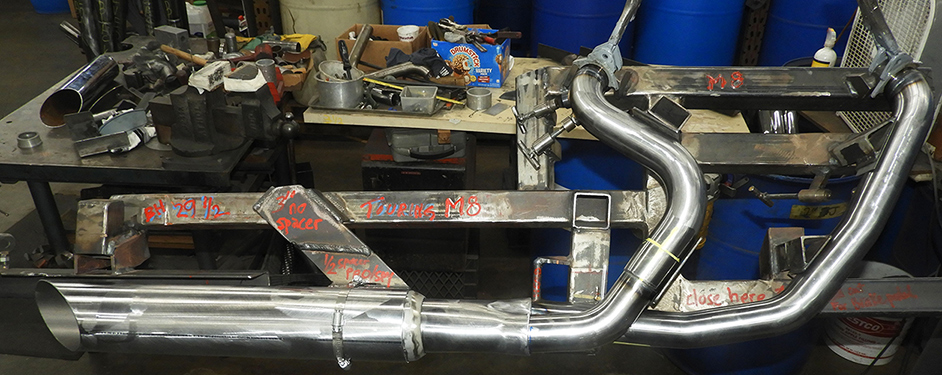
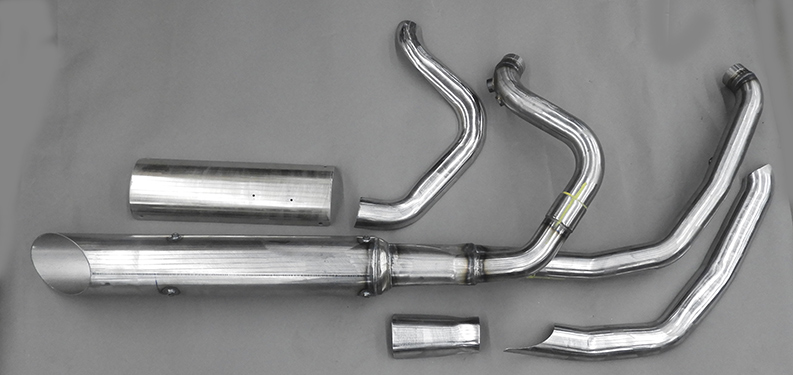
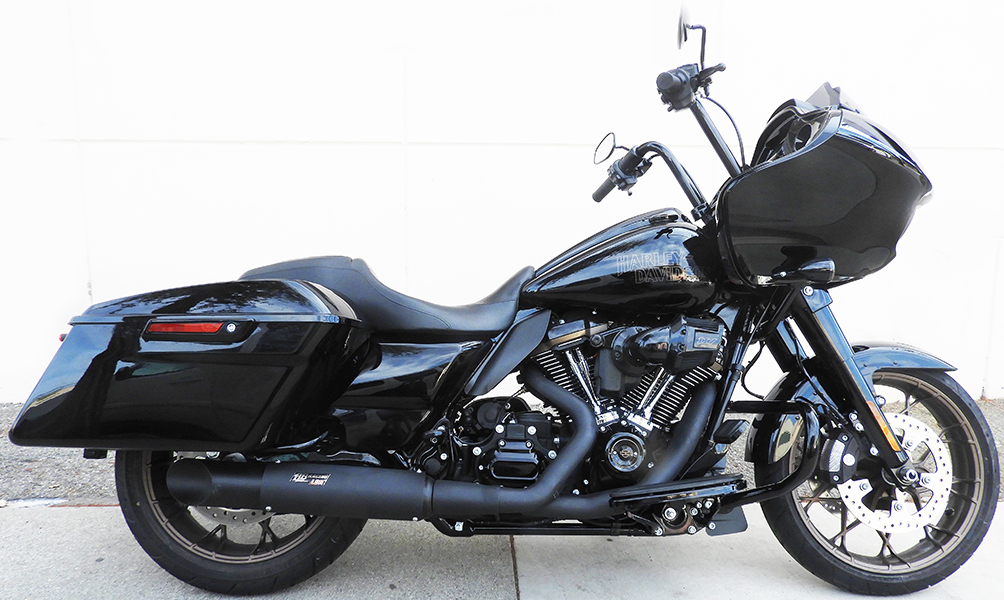




Thank you again Great product! J. S.
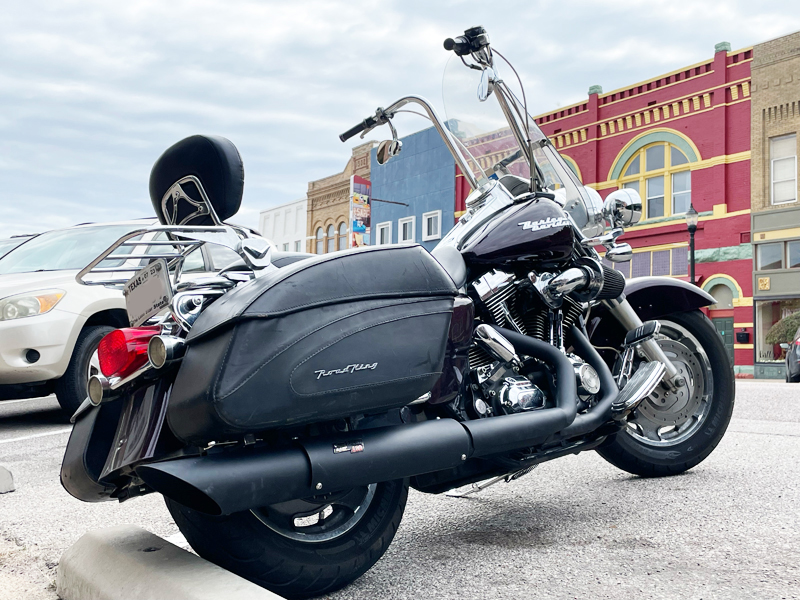
LSR 2-1 Black Hole...14 years later
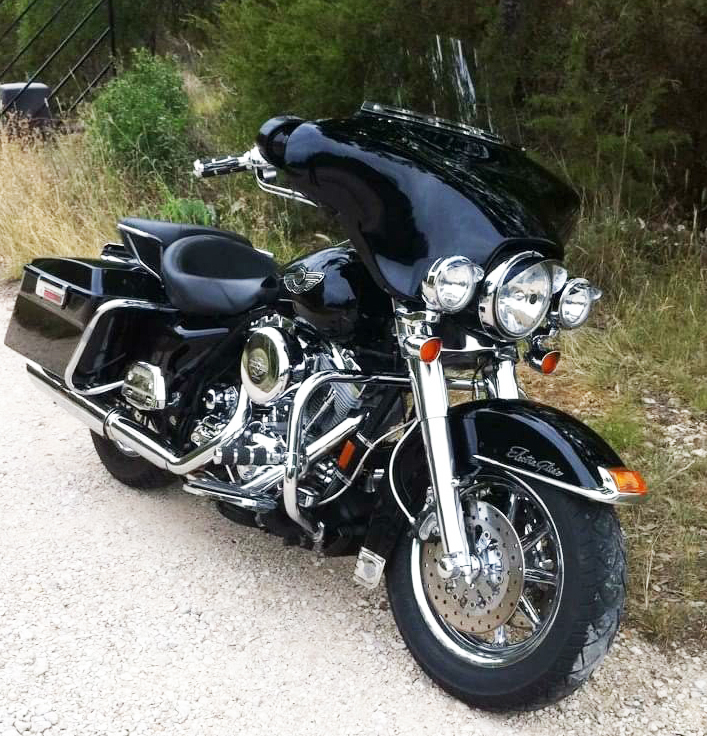
Customer writes: "This is my 2003 FLHTI with your Black Hole 2-1 I’ve had it on there since May of 2010, wonderful sound and performance."

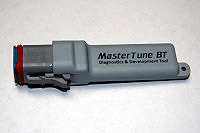
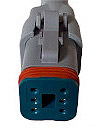
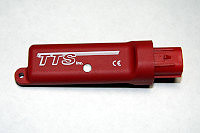
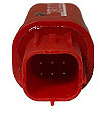
When you order the TTS MasterTune, a
LSR 2-1, and our RSR Air Fuel Ratio gauge, and a TTS
Camshaft (see below) there is a $100.00 discount. Real world.
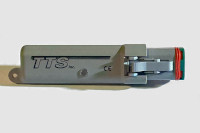
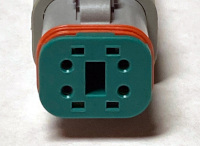
MasterTune BT Communications Interface - J1850 4 Pin
When used for calibration development, this interface marries to the ECM during the first ECM flash and further calibration development can only be performed on that ECM.
When used for vehicle diagnostics and data logging, this interface can be used on any compatible vehicle, even if already married to an ECM.
Mastertune BT Interface communicates to the PC via a wireless Bluetooth connection. Also includes a support loop to attach the interface to the bike via a wire tie.
Compatible with the following Delphi equipped Harley-Davidson Motorcycles:
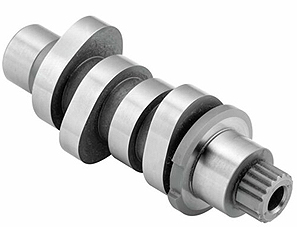
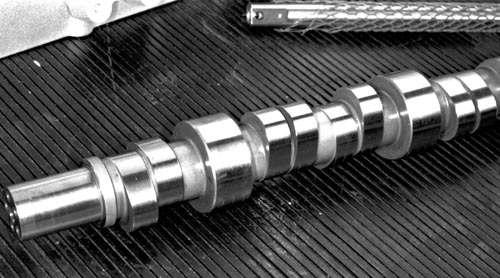
TTS M8
Camshaft left above. Mercedes / Illmore pushrod V8 Indy winning
265E camshaft to the right. Pay attention to the lobe design.
Ilmore found that with a pushrod design there was so much monkey
motion going on between the camshaft lobe and the actual valve
opening that it made more power and torque to gently (preload if
you will) open and close the valve. Slamming the valve open
introduced disastrous harmonics and accelerated valvetrain wear.
Steve Cole designed his TTS 100/150/175/200 camshafts plotting the
acceleration rates contrary to what others did i.e. banging the
valve open and shut. Years later Steve finds others are copying
his designs even if they do not know why he designed them that
way. Camshaft
descriptions.
If you actually ride instead of parking and talking about your
dyno session you will find the TTS cams will outperform all others
in the vital roll-ons in the 1000 to 4000 RPM range.
TTS M8 cams are priced at $275.00. $358.00 for Twin Cams. In stock
at RB Racing to pair up with our LSR exhausts and our RSR Air Fuel
Ratio meters.
Milwaukee 8 LSR 2-1 Black Hole Dyno...156Hp
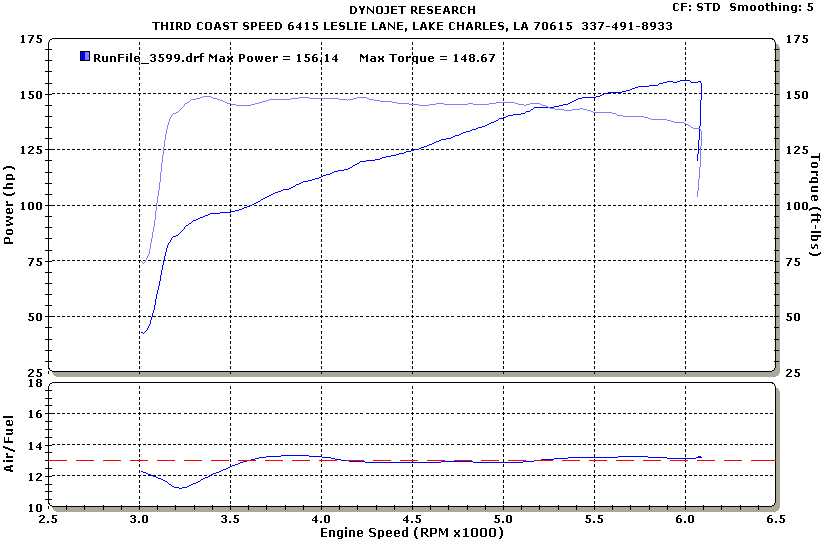
Customer writes: "M8 LSR 2-1 Black Hole Exhaust with 124 Rick Ward heads and cam 64 mm throttle body SS 124 cylinders and pistons, big inj, and air cleaner. Perry"
00-1397 LSR 2-1 Black
Hole Exhaust.
Milwaukee 8
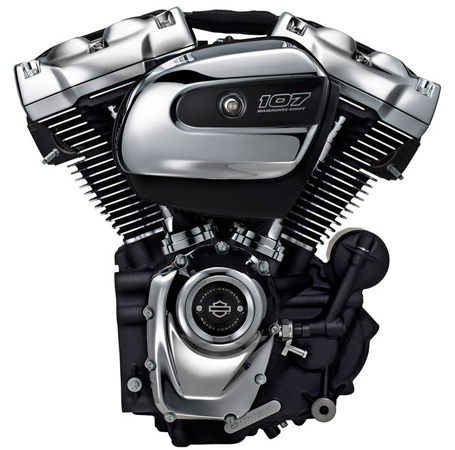
In 2017 when the M8 Dressers showed up
people kept asking about RB Racing releasing LSR 2-1 exhaust
systems for the new Harley Motor.
Well, we fixtured for them with a new muffler design that takes
into account the increased compression and displacement, and only
released systems when we were happy with the testing.
Testing has shown TTS cam changes along
with a 2-1 exhaust will make significant gains.
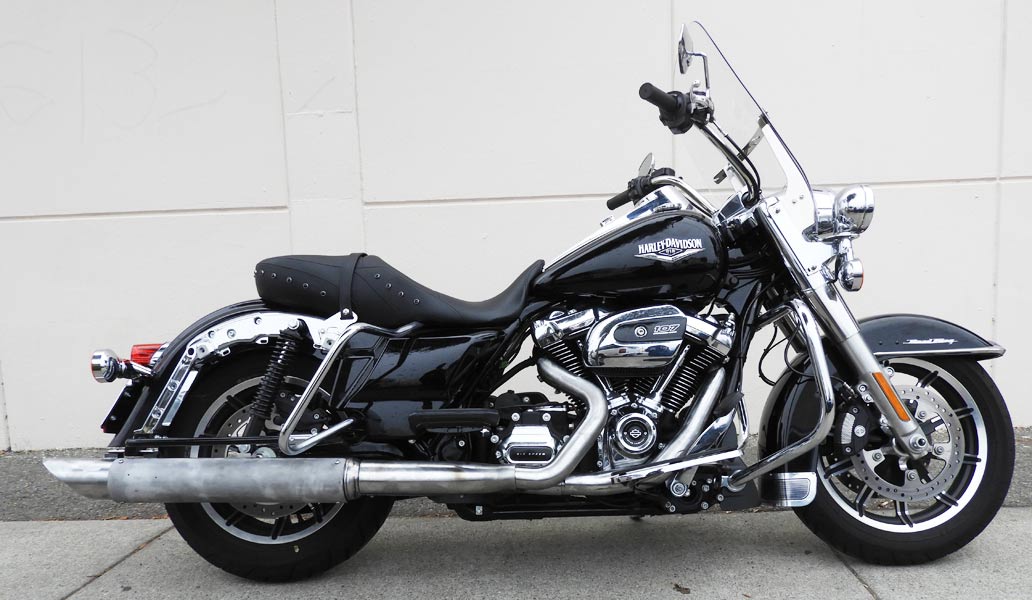
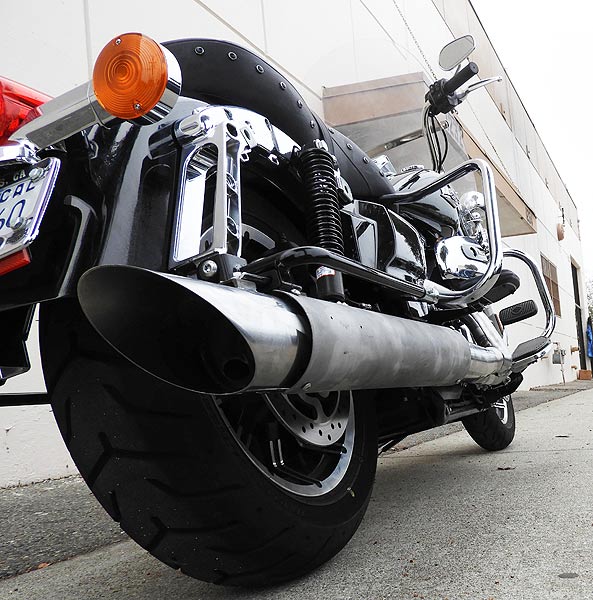
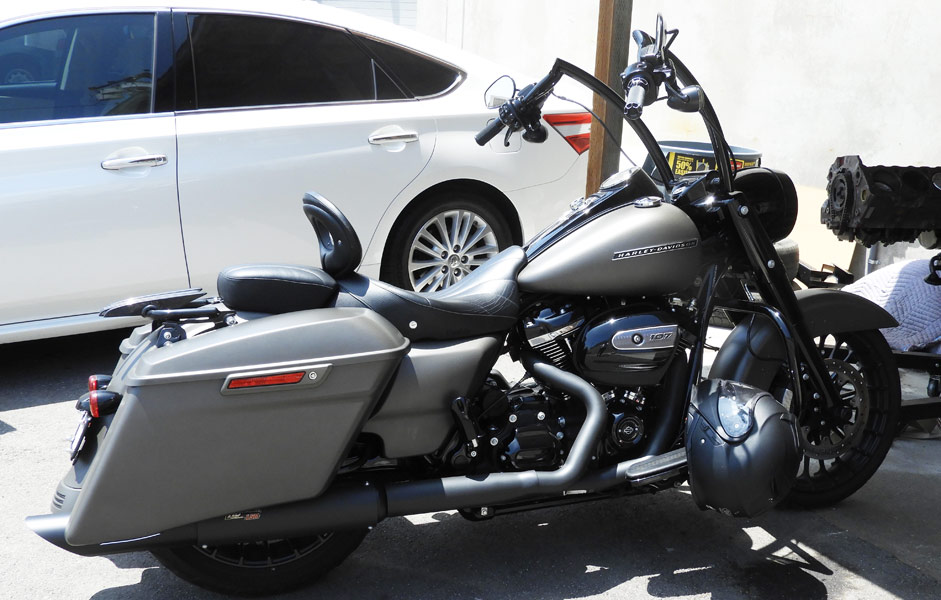
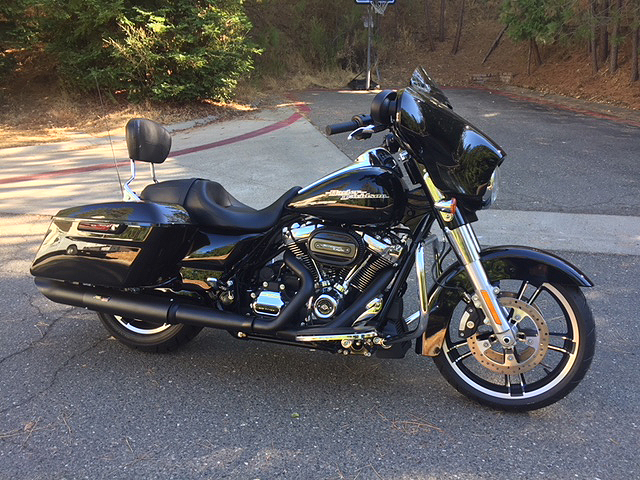
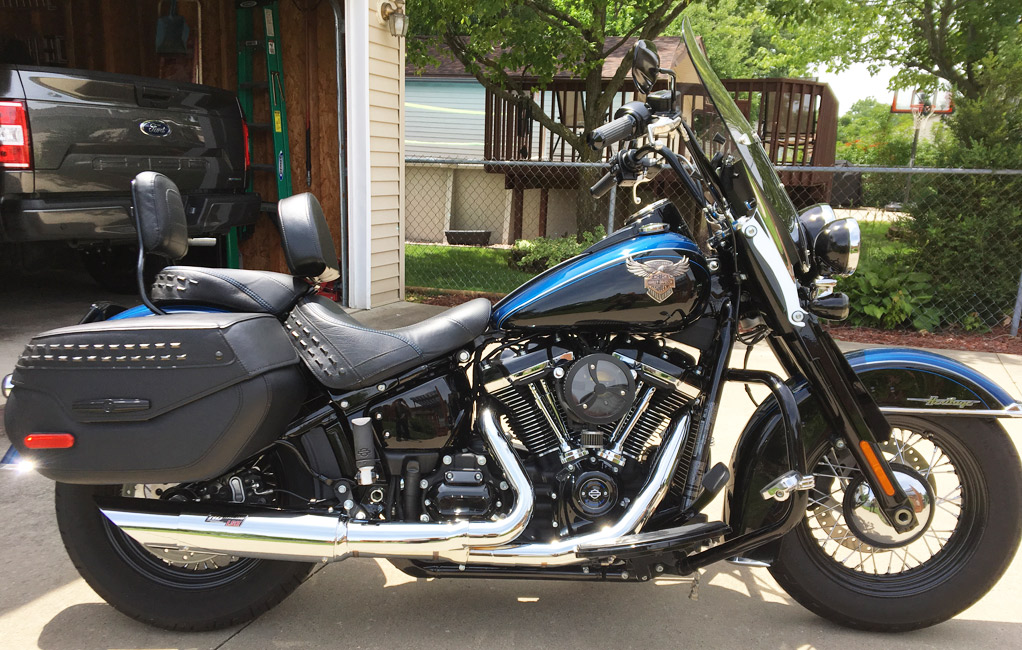

Dual Coat Black Ceramic Finishes
We have a lot more people looking for durable ceramic finishes and we think we have the best finishes on the market. In the late 70's and early 80's we tried all sorts of coatings and paints and even used porcelain on some of our products in the late 1980's. The newer ceramic finishes are tougher and we use both Polished Silver, and Semi-Gloss Black, to complement our usual chrome offerings. The newest "Turbo" Black finishes are a dual coat process that gives additional protection against scratches and nicks, providing two barriers against corrosion.
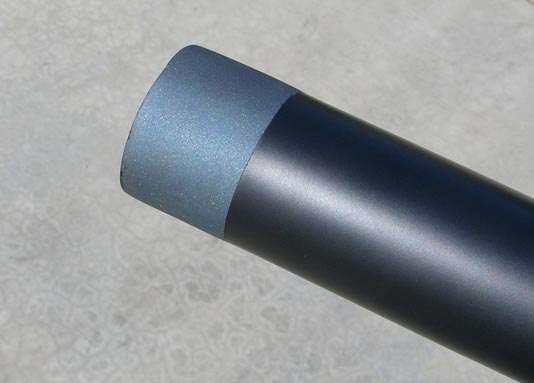
In more than 3 decades we have tried all sorts of black finishes: Kal Gard, VHT, Techline, and others. We also in the mid 1980's we even tried porcelain for awhile. It chipped and the heat distorted the parts. Most finishes will not survive over a long period unless they have a base coat to cushion rock strikes and scratches. The surface has to be perfectly prepared and most applications can fail if run too soon at elevated temperatures as they are typically baked at 450 to 500 deg F whereas the cure takes place at around 750 deg F. Lower temperatures will not cure the resins and they will fail once the bike is run. To get around this dilemma we have found the best solution is a 2500 Deg F Silver Ceramic cushion base coat and a secondary Black Semi-Gloss finish on top of this.
Dual Coat Black Ceramic finishes are therefore the most expensive
as they involve a triple process. First the parts are polished
to remove any tooling marks.Then the parts are zirconia media
blasted to prepare the surface. Then parts are cleaned. The
parts are base coated with a 2500 Deg F Silver ceramic and
baked. The next day they are sprayed with Black Ceramic and
baked for a third time.
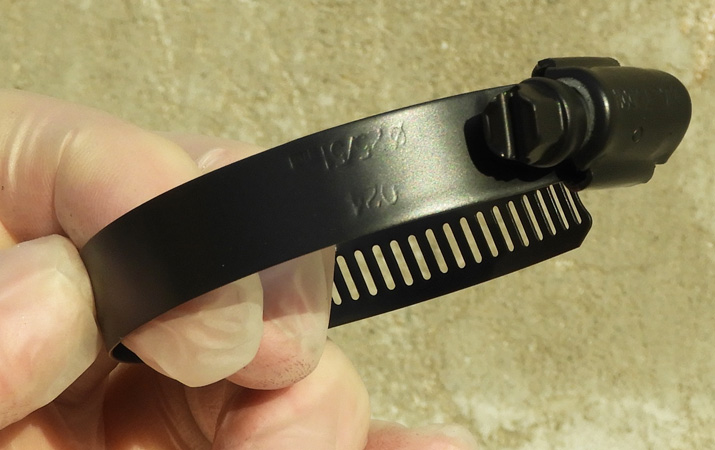

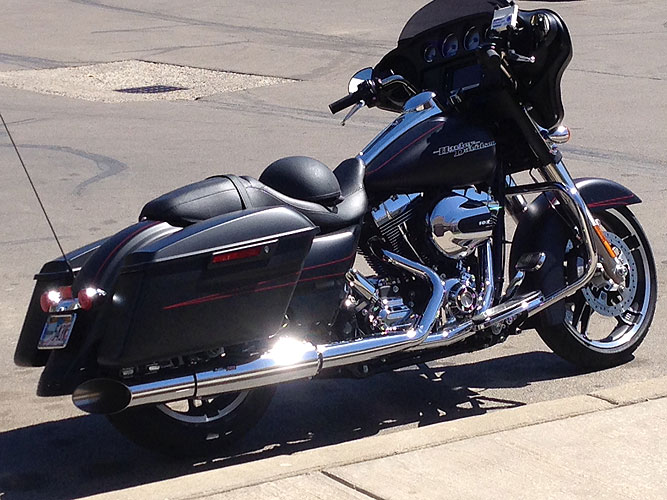
Customer writes: "Well here is a picture of my bike with your exhaust system on it. All I can say is it is everything it's supposed to be. The main thing and word is TONE.....wow what a tone, perfect! Thanks Ron L."
6000 Miles Later

Customer writes: "Here
is a photo of my 2015 CVO Road Glide with your (00-1236) LSR
2-1, Black Hole 1 ¾-inch exhaust system installed.
So far, the bike is a stock 110 CVO but I am contemplating
changing to SE 585 cams this winter for additional torque and
horsepower. I rode with the original Screaming Eagle exhaust for
the first 450 miles but the bike felt severely restricted and
was way too quiet. I could also feel that it was straining to
get up to the higher RPM range. That’s when I received and
installed your system and what a difference it made. I could
immediately feel the benefits of a free flowing exhaust. Not
only was the power and torque greatly increased but it’s a lot
quicker to accelerate to through the RPM ranges.
The benefits in sound
quality were also astounding. I can still cruise through
populated areas while generating a very reasonable high
performance sound and avoid making the man cranky but when it’s
time to pour the coal to it, you exhaust will also make the bike
sound like a Fire Breathing Dragon and holy shit it is fast.
As with the Black Hole system I had on my 2013 road Glide Custom
the folks I ride with like the quality of the sound and comment
it’s not too loud and can even be amazingly quiet when I need it
to be. As always, the fit and finish is perfect and with 6,000
miles on the bike now the chrome is still flawless and the
system looks better than the original or the other aftermarket
exhausts out there. I would recommend your LSR 2-1 Black Hole
system to anyone who wants high performance and a very good
quality sound without being obnoxiously loud.
Thanks for producing a really great exhaust system and an
excellent American Made product. Ray"
S&S T143 with B3
Heads
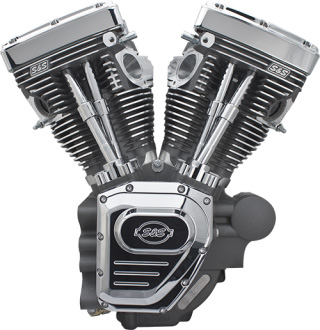
143 Cubic Inches for
your Dresser. Another way to spend $10,000.00 to $15,000.00 to
climb the Horsepower mountain. We are making exhausts for
these with our integral two bolt B3 flanges. The exhaust port
dimensions are not OEM Harley. There are slight variations
between the B1/B2 and B3 S&S heads.
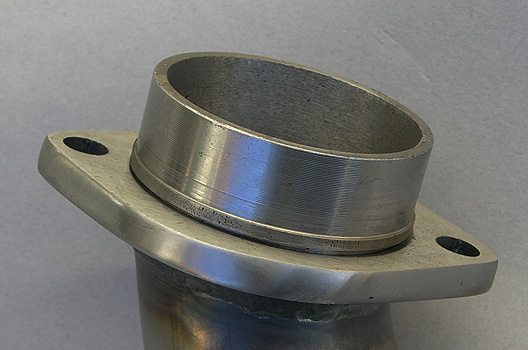
We have made custom
parts for these two bolt T143 B3 cylinder heads. Available for
the four product ranges we manufacture...Quiet (LSR 2-1 Black
Hole) to Full Race (LSR 2-1 Pro Stock). All use 2" primary
tubes.
The new two bolt LSR
2-1 B3 Flange is integral, free rotating, to the exhaust port.
Full tapered cnc machined venturi for 2" primary tubes.
Uses a machined1.875"
I.D. Billet Aluminum Gasket.
S&S SA B1/2/3 Heads
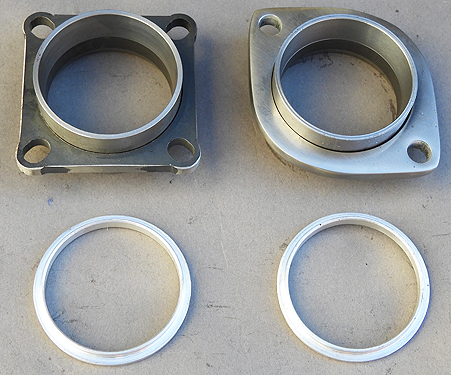
We have been asked by customers to provide LSR 2-1
exhaust systems for B1 / B2 / B3 heads originally found on EVO
and 145" S&S Tribute engines and later T143 engines. Early
B1/B2 four bolt flanges. Later B3 use two bolt flanges.We make
both. The diagonal dimensions are the same two to four bolt
patterns.
We have LSR 2-1, LSR 2-1 Pro Stock, LSR 2-1Pro
Stock Spyder and LSR 2-1 Black Hole designs for these three
S&S cylinder head variations.. Pictured above are our laser
cut flanges and cnc machined hour glass shaped venturis that we
heliarc to the B1 / B2 / B3 LSR 2-1 exhaust systems.
We have a specific fixture for the 126 S&S and T143 SAB2 / SAb3 Twin Cam Dresser systems as the billet cam cover is not OEM.
2013 Road Glide

Customer writes: "Sorry
for the delay but here is a photo of your exhaust system that I
installed on my 2013 Road Glide Custom. The bike is a stock 103
except for SE 255 cams and SE Air cleaner I added at the time of
purchase. Roughly 8weeks later I added your 00-1236 1 3/4 Black
Hole exhaust and they were well worth the wait. The fit and
finish are perfect and the look is excellent but the dramatic
change in sound and performance was really astounding over the
stock exhaust.
Your exhaust is what
really changed this bike from a geezermobile to an 850 lb rocket
that can easily hit 110 mph in the length of a freeway on ramp
with moderate throttle effort. I get a lot of positive comments
on the sound of the exhaust from the guys I ride with but I also
get quite a few from folks who are not even into motorcycles.
(seems everyone can understand performance when they hear it).
I am so convinced in the quality and performance of your exhaust
systems I just ordered a 00-1236 for the 2015 Road Glide I just
traded this bike in on
and a 00-1371 Spyder for my 2001 Heritage Softail. Thank you for
building a truly excellent American Made product. Ray".
117" 124HP
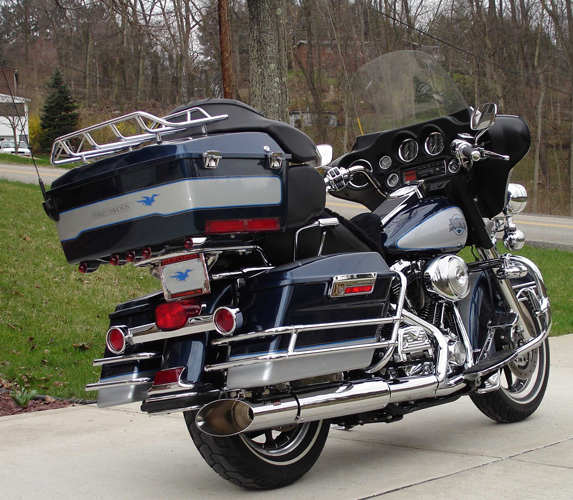
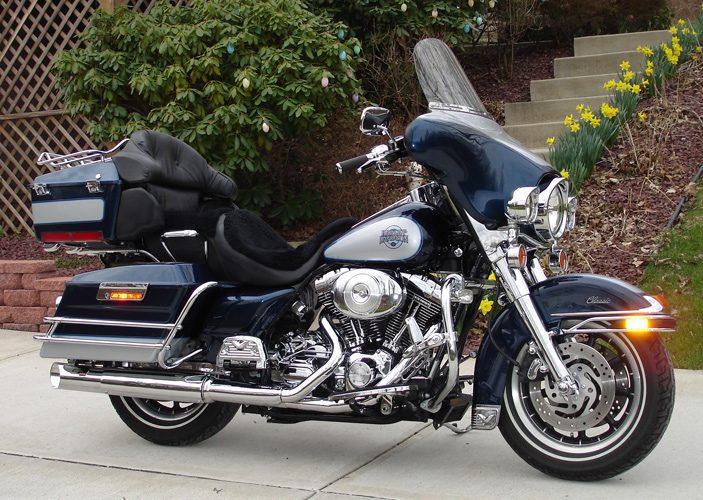
Customer writes: "
Thought I would send a couple pics of the Black Hole pipe on my
2001 FLHTC
It had a 95ci engine when the pipes were installed and I have
since upped that to 117ci that dynoed at 124 hp 134 tq
with this pipe. It sounds great.. not too loud but still has a
good note to it, this is great since I go to work in the predawn
hours and I can slip out without annoying the neighbors. it also
helps with the Sleeper look I like. You are welcome to use these
pictures.T.A."
124" 153 HP Tourer
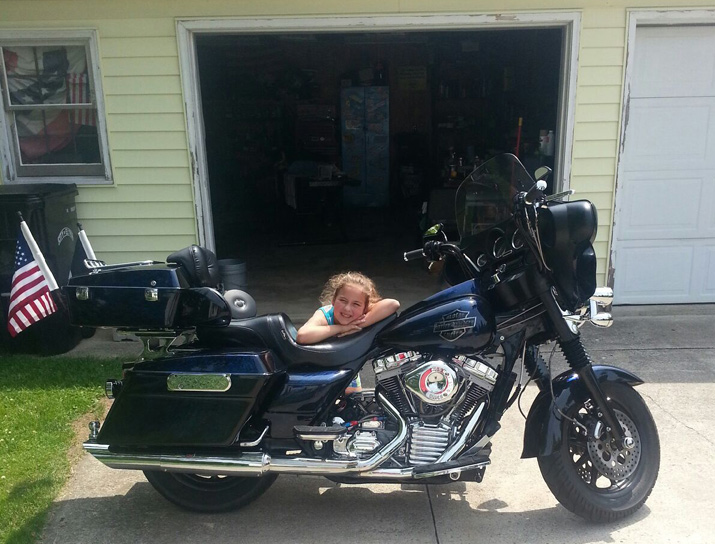
Customer writes: " I have a 11.5cr 124 with ported 110 heads, S&S 640G cams, bored S&S G carb.....attached is the dyno sheet. Is this tq curve normal for the 2" primary Blackhole pipe? The welds and the chrome are second to none! I am absolutely satisfied with the fit, finish, and sound of the Blackhole! 153hp/149tq AND I can hear the radio and have a conversation with the girlfriend.
PS: I also have your
swingarm mod done-----work of art!!!! Thank you guys for the
great products. Dave"
2011 SE Road Glide
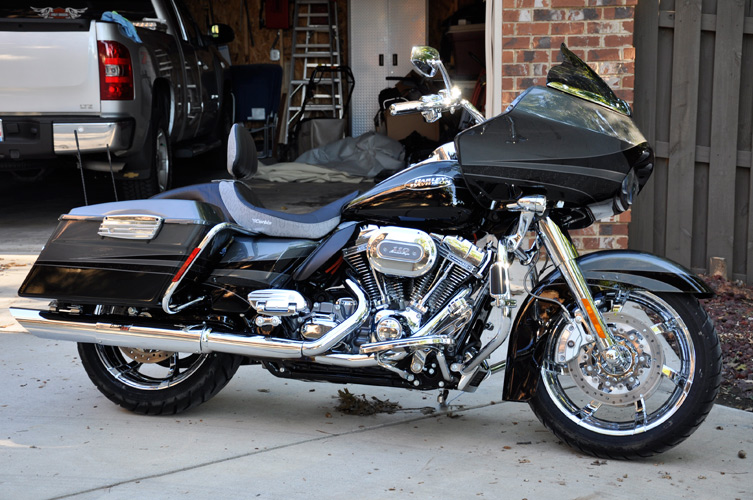
Customer writes: "Folks,
See attachment. The pipe is working out wonderfully. I could not
be happier and am happy with performance, fuel economy, sound,
looks and great comments I receive whenever I'm out and about."
00-1236 Slash Facing Down
2006 FLH-X
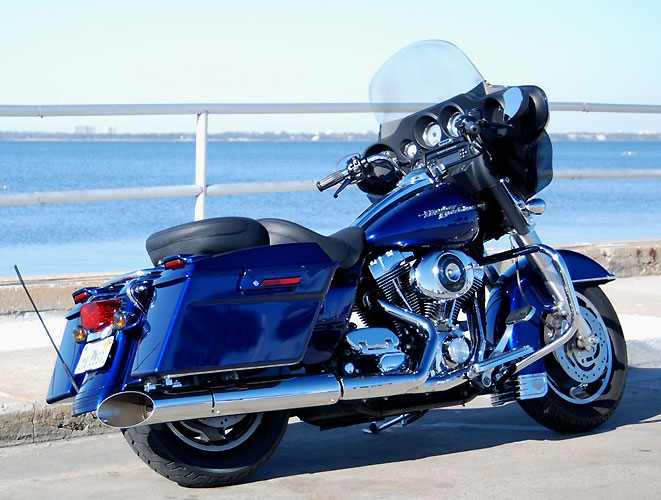
Customer writes: " Hey, gang! Here
are the pictures you requested of my exhaust installation on my
scooter.I have a 2006 FLHX-I that was
awakened by the 00-1236 2-1 Black Hole exhaust! Midrange is
incredible and I am nailing down about 39 mpg in town. Sound
level at cruising throttle level is much lower than brand-x and
I can actually hear my radio again.
However, when you hit around 3 grand, it really gets the attention of the brain dead cage driver next to you! Installation was much easier than wrestling the old exhaust off and the quality is incredible. Thanks a bunch for a high quality, American made product that does everything and more that is claimed. Regards, Rick." 00-1236 Slash Out.
General Mounting Instructions for EVO and Twin Cam FLT/FLH series.
103"

Customer writes: "It
took all of the six weeks you promised but it was worth the
wait. This is a very high-quality product; just handling
it feels good. Fit and finish, pipes, mufflers, and heat
shields are top-notch and once it is installed it is solid as an
anvil on a sidewalk.
However... a simple set of "install in this order" instructions
would be welcome. It's not all that hard to figure out but
it's easy to go up a couple of dead ends before you figure out
which pieces need to go on first, second, etc. And while you are
figuring that out the Ultra Black Silicon Seal on the slip
joints is getting tacky and nothing wants to go together - or
come apart, either, without effort. I wound up using some
hi-temp anti-seize; we'll see how that works out. If you're the
kind of guy who can cross-thread the lid on a ketchup bottle,
though, you better put your Crescent wrench and vice-grips back
on your picnic table and take the system somewhere to be
installed.
It's louder around town than I expected but I'm not inclined to
send it back over that because the power is very, very
noticeable, even on the 103" performance build I just finished;
it lets the heads and cams breathe. The idle reminds me of a
big-bore inboard boat motor burbling along; the internal volume
of the can makes a nice hollow echo. On the highway the
cruising sound is pleasant, but far less than, say, a T-header
but noticeably more than the Screaming Eagle touring pipes the
Black Hole replaced. But wait! There's more!
Drop a gear, roll the throttle on full, and the hammers of hell
just ain't in the contest; it ROARS, advertising power, real
power, not just useless "look at me" noise. Yes!
This was dollars well spent. Pilgrim". Part Number
00-1236.
Actually the
instructions are downloadable (see top of page). Anti-seize
blows out...sort of OK on chrome but a definite no-no on Black
Ceramic. No sealant is needed at all on slip joints but
non-hardening Permatex 598B can be used. It does not blow out,
provides some lubricity...but is not absolutely necessary. Slip
joints (2) are meant to "slip".
2009and later Models Covered
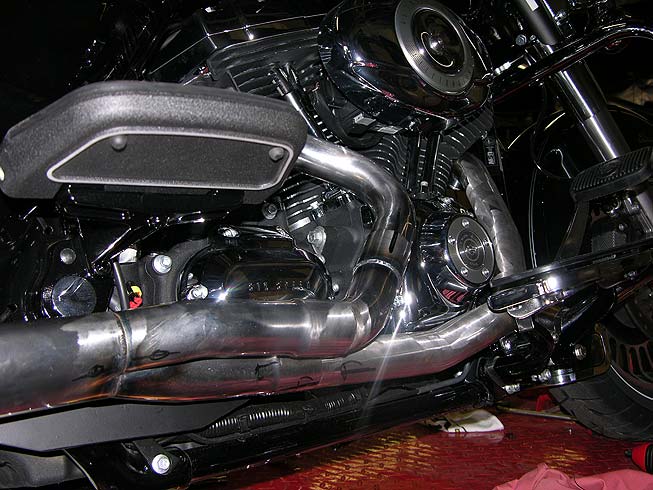
2009/2010 Frames are changed.... Floorboards are changed. We have prototyped the 2009 models and are shipping orders. We build to order. Options on tail section and four different finishes. 00-1367 Pro Stock Spyder shown. LSR 2-1 Black Hole designs have also been verified for the 2009 and later models.
Starting in 2010 Models have revised O-Sensors, smaller and different location. Harley was trying to avoid O2 warranty issues (heat damage), or perhaps styling issues, so they went to heated units and moved them downstream. We have these covered.
2010 O2 Sensors
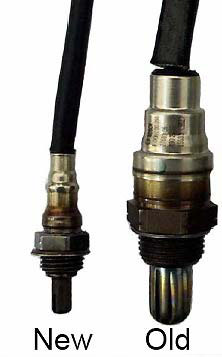
2010 FL and later series use the new small heated O2 sensors. We are tooled for these.
109, 414 Miles
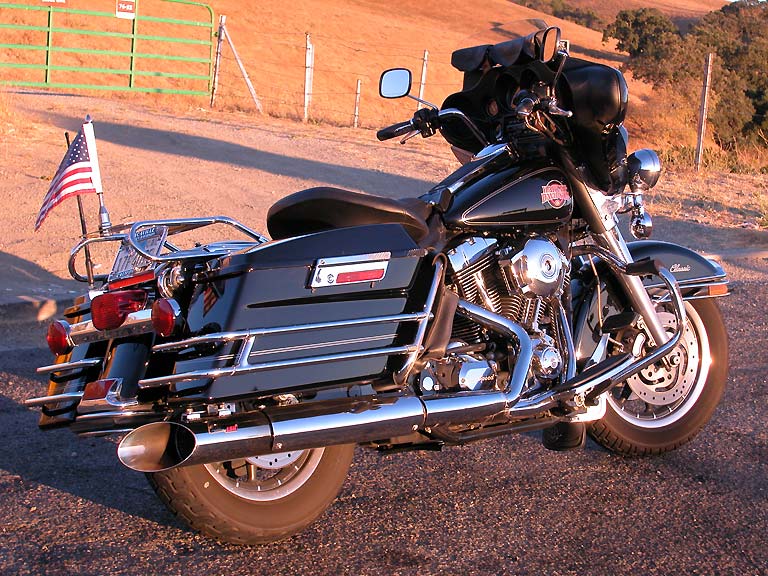
Customer writes: "Attached is a picture of my 04 geezer glide with 109,414 miles. As you can see, I have an RB Racing Black Hole exhaust. I installed the exhaust on the second of September 2006 with 57,105 miles on the bike. That is 52,309 miles, plus two wrecks. Seems like I always end up on the right side too. I think my problem is going a little fast and not paying enough attention far enough ahead, so I got new glasses and had the motor pumped up a little. Even with all my mistakes, the exhaust looks and performs great. Love the performance, appearance and quality of your system. THANKS! Tom".
All SS Titanium Finish (discontinued
late 2016)
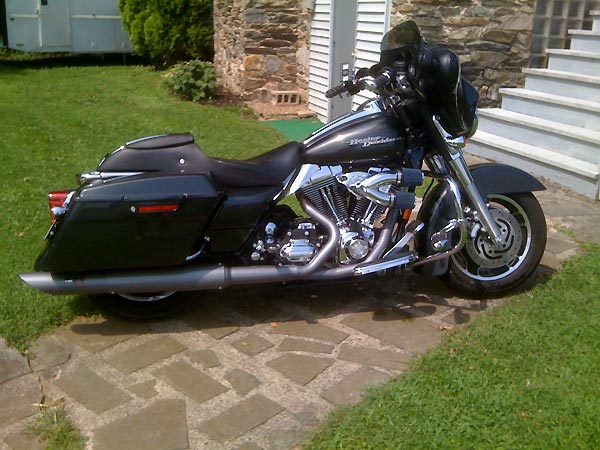
Customer writes: "I received the Black Hole pipes last week and put them on over the weekend. Good fit and I love the sound. I had a dyno run before and after and the change (Black Hole exhaust and an S&S duel feed intake) produced a 20% HP increase, -- Thanks. Attached is a picture of my 2007 Street Glide, HD black pearl paint and your titanium pipes with titanium heat shields. Regards Ron. " 00-1236 with full heat shields.
Silver Certificates
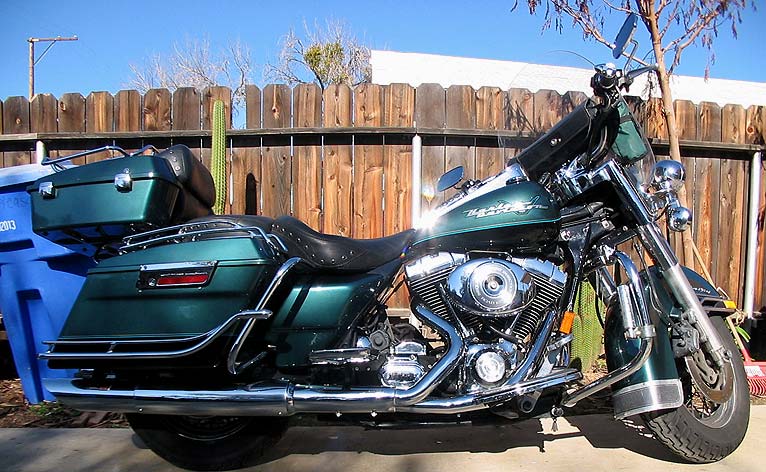
Customer writes: "As promised, here is a shot of the Black Holes installed on my 95" 2000 RK. I could not be happier with your product. When I realized my H-pipe was cracked, I needed a fix, fast. I ride about 3k miles a month on this bike, and can not have it down. I found a conversion kit to put true duals on. Seemed like a cheap solution. As the old saying goes, you get what you pay for. After the first hundred miles with the true duals, I made the decision that I could not deal with the 3mph decrease in top end, the slower acceleration, and the noise. As I pried open my wallet, cleared the cobwebs, and pulled out those silver certificates, hopeing the sunlight would not cause them to turn to dust, I realized that there was only one solution. I called you and ordered my pipes. You had what I needed in stock. Due to my travel schedule, I needed the pipes fast. You went to extra efforts to get them to me on time, and I received them a day earlier than I expected. It has been a long time since I last experienced customer service, so cudos to you.
I removed the old pipes on my lunch hour, and started the install that night. Finished up the next night, fired up the bike, and fell in love with the sound. I took the bike to the local dealer to have it put on the dyno. When I arrived in the pouring rain, I rode the bike into the service bay, and shut it down. The service manager wrote up the work order, then asked if I would start it again so he could hear the pipes. I think you have another customer. The bike is tuned, and running perfect. The power increase is noticeable at all speeds, and top end has increased by 6mph. At 80, the bike is a very comfortable noise level. Since it has been raining ever since I installed the pipes, I have avoided a long ride, but will be putting another 800 miles on next week, so I will be thinking about the next RB racing goodie I want for my bike. About that injection system..."
We rarely have finished pipes on hand as we build to order. Sometimes people have to hold off due to job loss, family emergency etc., so we either hold the pipes for them, or sell them to the next customer. Part # 00-1236 with four heat shields (rear shield standard).
Top Fuel Pilot

Steve Heidner's Glide. Steve is used to Nitromethane as a Top Fuel pilot and professional AHDRA Team manager but opted for quiet power with his street machine. Steve also has an LSR 2-1 on his 1200 Sportster that is not so quiet. Sometimes it's better to go fast and not draw as much attention. Steve is the full time crew chief for John Breckenridge's AHDRA Pro Fuel and Top Fuel bikes.
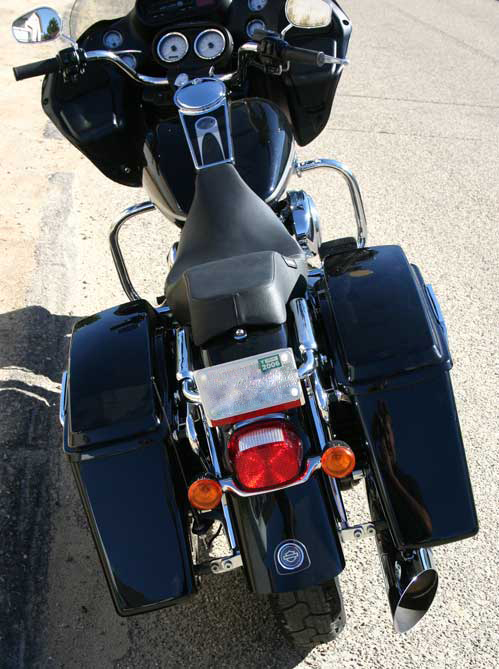
This is the latest version of the LSR 2-1 Black Hole exhaust. We cranked in a bit more ground clearance by moving the pipe up and in and rotated the heat shield upwards to give both more bag protection and more gound clearance. Dual O2 ports are standard on all LSR 2-1 Black Hole systems.
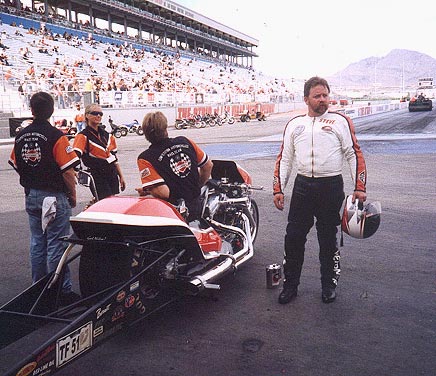
Steve writes " Steve Heidner here. I hope all is well in Fruitland. I just wanted to thank you for being the only pipe manufacturer willing to take the time and make the sacrifices necessary to produce an absolutely outstanding pipe. I am so impressed with my new Black Hole pipe that I recommend it to everybody that asks about it. I constantly get compliments on it and am asked about it`s performance frequently. My Road Glide runs perfectly with an amazing amount of midrange power for a basically stock motor. I love the deep throaty sound that it lays down without being obnoxoiusly loud. With my background being a toolmaker and machinist I can truly appreciate the quality in manufacturing this product shows.
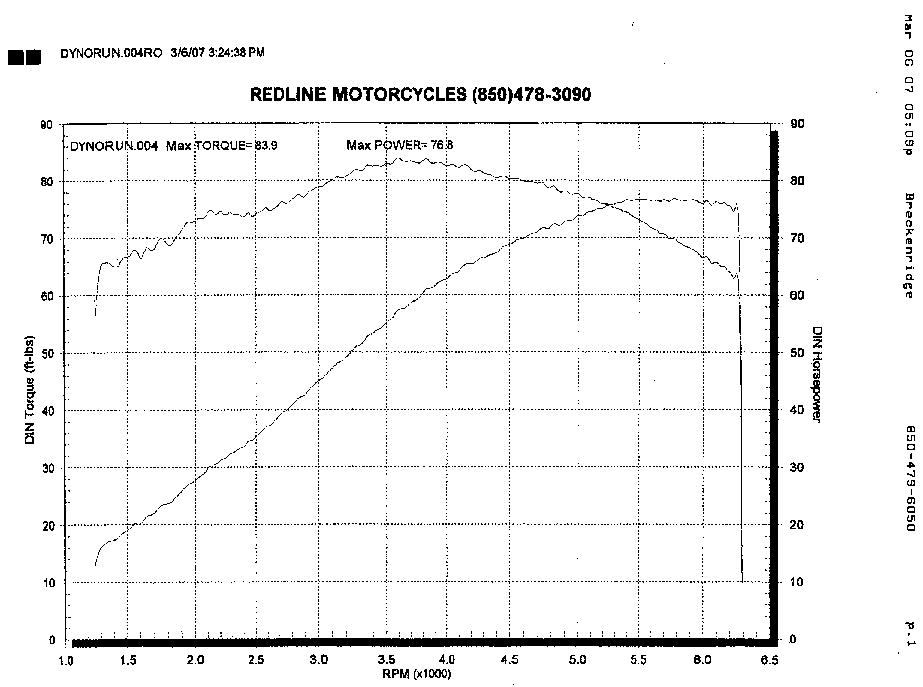
I hope to see you at the track this year.
Sincerely, Slidin Steve Heidner."
Steve is used to riding explosive Nitro Burning 800hp Top Fuel Bikes. The LSR 2-1 Black Hole gives his Road Glide great performance and a beautiful sound without excessive noise. Steve would not use it if it didn't work...He is a RACER! Once a racer always a racer.
Quiet Power..
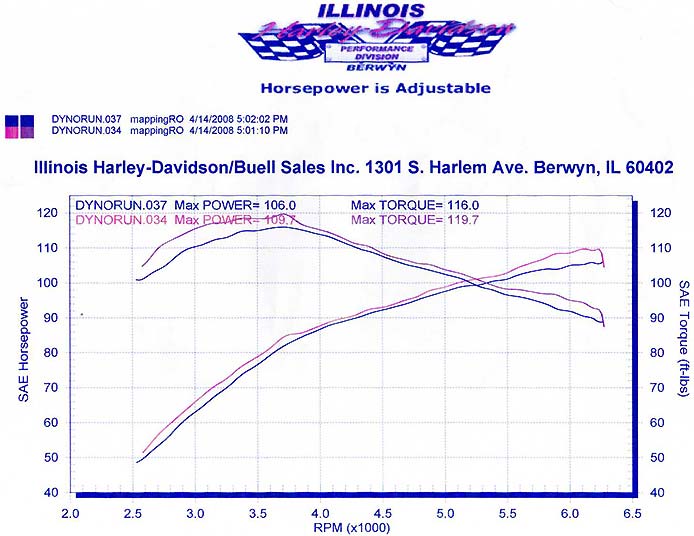
Customer writes: "To Whom it may concern, Just wanted to drop a line and let you know how satisfied I am with my new LSR 2-1 Black Hole exhaust on my 117" Road King. It has been fun breaking in the new motor. We just dyno'd the bike and came away with a 119 ft/lbs of torque. My fat ass bike really launches now. I will be using your exhaust on a lighter bike in the futureThanks, John".
True Duals and Aluminum Butt Plugs
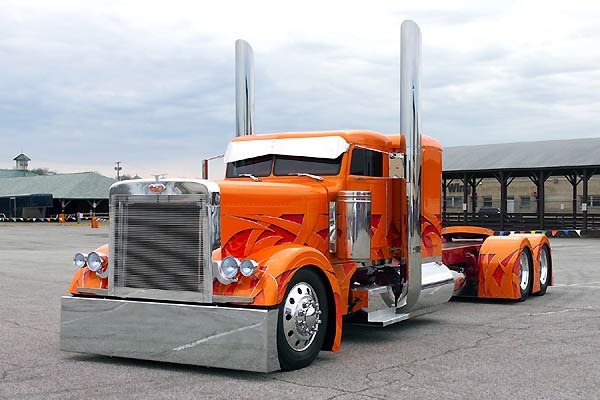
Customers ask us why we don't make "True Duals". While the name has a certain ring to it, with "True" sort of impugning everything else you might consider. Well, we won't make things that don't work, like dual pipes, dual pipes with aluminum butt plugs, or even a falsie left pipe that does nothing. Now, we like Fishtails, and all sorts of things like that which are traditional and pretty. We just aren't going to make them.
Customer writes: " Hello RB Racing ! Just wanted to drop you a note to say THANK YOU, THANK YOU, THANK YOU!!! I changed the pipe on my Roadking from a popular name brand "TRUE DUAL" to your LSR 2-1. Had the bike dyno'd yesterday and what a difference, The HP number jumped from 82 HP to 89.95 (call it 90) and the torque number jumped from 96 ft lbs to 102 ft lbs. Nothing else was changed but the pipe. Anyone know some one looking for a set of used true duals? While those numbers aren't huge or record setting they are much, much better. In addition, the bike runs tons better, no more cracks or pops and runs smooth as ever at RPM. Again , I can't thank you enough for producing a product that meets the need and not necessarily a product that boasts bragging rights that are unsubstantiated. Mike".
New Dual O2 Meters
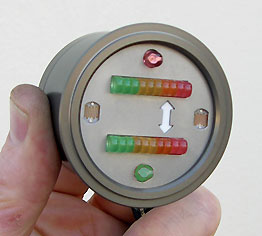
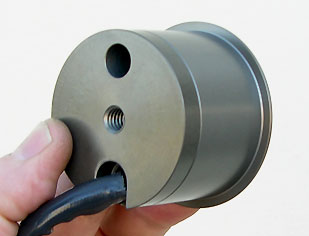
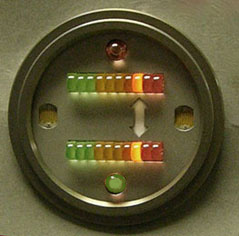
For Delphi or Marelli EFi sequential injection our new RSR Dual Air Fuel Gauge displays the fuel mixture in both the front and rear cylinders separately. The gauge is housed in a hard anodized round enclosure in a standard 2" format with a 2.250" bezel, center back mount, with a 5/16" x 18 stainless socket head cap screw. The gauge will show fuel ratios from 17:1 to 12.0:1 (or richer). The gauge is visible in daylight and automatically dims for nighttime operation.
Scale is, left to right, lean to rich: three greens, three yellows, two orange and two red l.e.d.s.
The white arrow indicates the maximum power mixture, the second orange light, which is 13.2:1. Transitory enrichments should not, if the engine is warm (>200F Oil temp), go past the first red light. Readings at the far right side of the scale, the second red light, are simply too rich. Proper closed loop operation will cycle back and forth from green to orange around the center of the display.
Soot
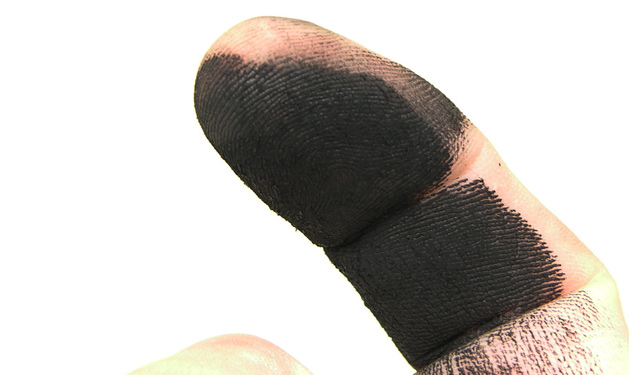
Whenever you look at an exhaust and see it caked in black soot you know the bike is not running or tuned correctly. Back in the mid 1980's we did a carburetor development program for Keihin Corporation for their 41mm CR Race carbs on both Shovelheads and the new Evolution motors. When we were finished the bikes got 56 mpg cruising and 46 mpg if you ran them harder...and after 500 mile tests the pipes were perfectly clean inside and the exhaust ports were dead clean.
If you take the
exhaust system off a modern Closed Loop BMW, as we have,
you will find them dead clean or whitish inside. Harleys
should be the same.
We always ask
what mileage people get from their "tuned" or modified
Harleys after "Dyno tuning"....The universal answer is
37 mpg or less. If they don't know, we ask them if they
have to gas at 100 miles. Most do.
Once a customer bought an exhaust from us and took his bike to two different dynos in search of the "117 Hp" he was looking for for his 103...He got 110Hp. After pissing and moaning we told the guy to give us our exhaust back and we found it caked in soot. So much for tuners and their tail pipe sniffers that see lean reversions...They just kept adding fuel. You tell the customer to put on our RSR Air Fuel Gauge to monitor the mixtures F/R in the real world...No, they want a "Dyno Tune". We have dynos...we know what they do and can't do.
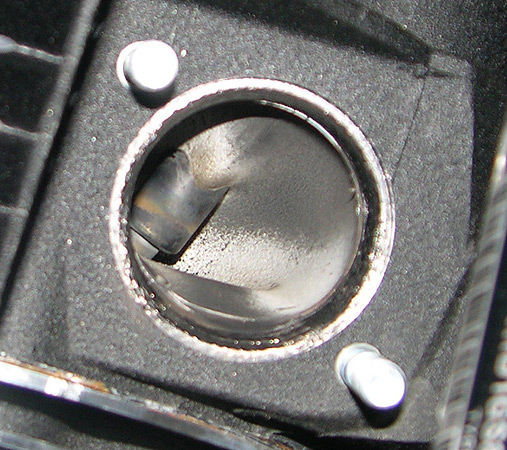
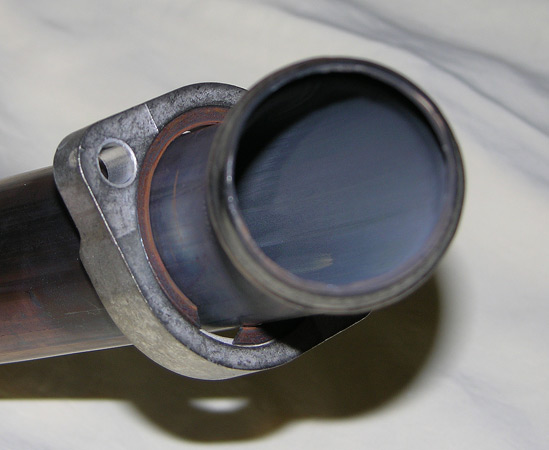
Pictured above is the exhaust port from a 2017 Dyna Low Rider S with about 100 miles on it. No soot. Delphi engineers seem to have done a very good job. Looks like the port you would see on a BMW. Now, when your "Tuner" gets finished with it, it will most likely be full of soot. Logic plays no part in people and their toys. EFI is complex...put in different cams, change air cleaners, port the heads and all this goes out the window. Brave new world.
No soot.
Fuel Injection..A Reality Check
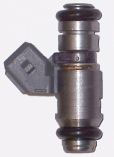
OEM Harley
Delphi Injectors come in various ratings: 3.91
grams/second; 4.35 grams/second; 4.89 grams per second
(CVO); and 6.00 grams per second. These ratings are
static i.e. shorted open. Pulsed static is about 90%
of this i.e. what you could expect if you maxed them
out in your ecu calibration software. If you hold them
to an 85% duty cycle they, respectively, offer the
following horsepower potentials: 105 hp; 117 hp; 131
hp and 161 hp. Now, you can squeeze more out of them
by going past 85%, but this is the point where they
are still controllable.
We get calls
from people building wazoo big engines and they are
still running the stock injectors. We suggest you get
the right injectors for your engine building projects.
We offer a several calculators for those messing with
efi systems. Fuel
Injector Calculator Professional Injector Pulse
width Calculator.
New Small (12mm) and Older
(18mm) O2 Sensors


In 2010 FLT/H series went to the new small heated O2 sensors. The Dynas and Softails went to these in 2012 and the Sportsters in 2014.
We are tooled for these smaller sensors on all the newer models. The small O2 Sensor models have a floating ground voltage offset that has a complex scheme that varies the signal to meet emissions purposes. If you think you are going to trick these you are in for a surprise.
You must specify the year of your motorcycle when ordering the RSR Dual O2 Gauge. Models with the small OEM O2 sensors will require two 18mm O2 ports in addition to the 12mm ones to monitor your bike as you ride. Our RSR Dual Gauges will monitor the 18mm high temperature O2 sensors we supply. It is the only method to monitor both front and rear cylinders of your bike as you ride. Real world observations to perfect your tune. Better than a dyno which tends to overheat your motor quickly skewing your tune.
RSR Air Fuel Ratio
Gauges...Dyno on your Bike
The Mother of all gauges! Not a gauge, but a precision tool that will tell you exactly what your engine is doing in real-time. Gives you instantaneous read-outs of air/fuel ratios from 17:1 to 10.5:1 and indicates maximum power ratios. Four color display is easily read in direct sunlight and automatically dims at night. Waterproof, billet aluminum construction. Your significant other will cheat on you but this gauge will never lie! It won't keep you warm at night, but a perfectly running engine will look and sound the same when you wake up next to it the morning after.

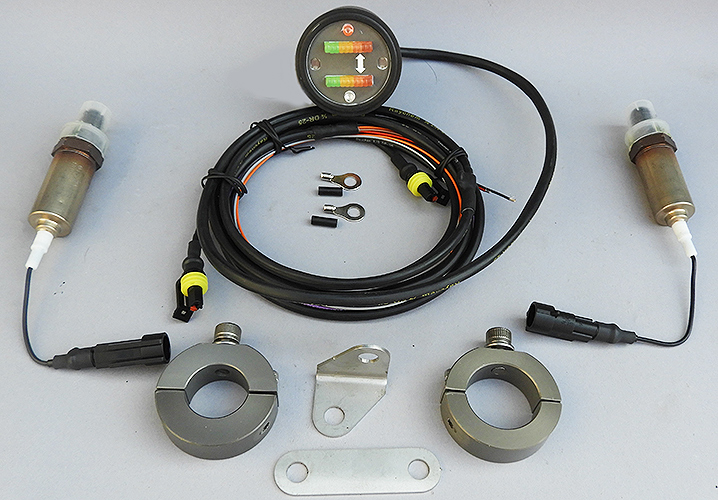
Single RSR O2 Gauge: Reads the front cylinder in non-efi models. It is simply the best way to evaluate the tune of your motorcycle and saves expensive and often inaccurate dyno time. Real world tuning while you ride...Observe and then make adjustments. Mounted permanently. Waterproof.
Mounts....Roll Your Own or Buy One
The gauges have a center back mount 5/16" x 18 x 1/2" Stainless Socket Head Cap Screw and stainless lock washer. You can fab your own bracket for this or use the 06-1025 hard anodized Billet Mount System for either 1.00" or 1.25" handlebars $49.95. Optional is the 06-1024 two piece laser cut 304 Stainless Steel mounting tabs for either near handlebar clamp or up the handlebar mounting: $9.95.
Since we have been
doing closed loop fuel injection
systems for Harleys for more than 30 years and have
been putting O-Sensor Ports in our exhausts for the same
amount of time, we have both single and dual O2 ports for
our full range of exhausts. Our RSR
Air Fuel Ratio Gauge is the best investment you can
make for monitoring and optimizing your engine tune.
All LSR 2-1
exhausts come standard with one or two O2 ports
(Sequential EFI models)...18mm or 12.5mm. O2 or Lambda
sensors are a necessity for either carbureted or non
closed loop efi (Weber Marelli and Early Delphi) Harleys.
We should know, as we have a lot of experience with them
and have been doing Closed Loop EFI systems since 1989.
The Single and Dual gauges ship with six feet of MIL-W-22759/32 wire. The first 24" is Raychem DR-25 sealed on both ends. If you wish to have a connector at the 24" point there is a $50.00 charge to install either six position (single gauge) or eight position male/female Deutsch DTM connectors with Raychem DR-25 sleeving.
The gauge is housed in a hard anodized round enclosure in a standard 2" format with a 2.250" bezel, center back mount, with a 5/16" x 18 stainless socket head cap screw. The gauge will show fuel ratios from 17:1 to 12.0:1 (or richer). The gauge is visible in daylight and automatically dims for nighttime operation. Only a single L.E.D. illuminates.
Very easy to interpret at a
glance. Scale is, left to right, lean to rich: three
greens, three yellows, two orange and two red l.e.d.s. You
simply cannot "read" spooling digital numbers.
The white arrow indicates the maximum power mixture, the second orange light, which is 13.2:1. Transitory enrichments should not, if the engine is warm (>200F Oil temp), go past the first red light. Readings at the far right side of the scale, the second red light, are simply too rich. Proper closed loop operation will cycle back and forth from green to orange around the center of the display.
It is simply the best way to evaluate the tune of your motorcycle and saves valuable dyno time. Mounted permanently. Waterproof.
Whether your bike
is carb or efi this is the best way to tune...By riding
and observing, not on a static dyno. Dynos are not exactly
real world in terms of loads, airflow, or transitionals,
and even if you had a million dollar AC Transient dyno
room, you would still have to do real world testing. The
gauges are dead accurate and are millisecond fast
responding which makes it very simple to interpret or
remember, even at a glance, while you are dodging cars
watching for cops. We have a Superflow
CycleDyn which gives a better real world correlation
than other dynamometers but we still evaluate air fuel
ratios when riding.
Anyone who tells
you optimizing tuning is easy is full of shit. Engineers
at Ford say they spend two years just perfecting tip-in or
initial throttle openings. Ride, observe,..then change or
edit. Real world.
Pretty soon
Harleys will all be watercooled then you really won't be
able to tell the difference between Milwaukee and
Hammatsu. "The Man" will be sniffing your butt and
planting microchips and gps modules up your ass so they
can mail you a speeding ticket and keep track of your
movements. They already have data recorders on your car so
they know what you were doing when the biggie happened.
Brave new world. Monitor your engine to get the most out
of it before the NSA monitors your tail pipe.
RSR AFR Gauge: Customer Comments
Customer writes: "When the gauge arrived I knew it would be of a very high quality, it has far surpassed my expectations. I was very eager to get this installed and take a look at my tune. Amazing to see how little adjustments on the carb effect the AFR. As a result of this gauge, I have dropped one size on the low speed jet, raised the clip on notch and confirmed the main jet on my Mik48. Thank you, I really like this gauge. Ed"
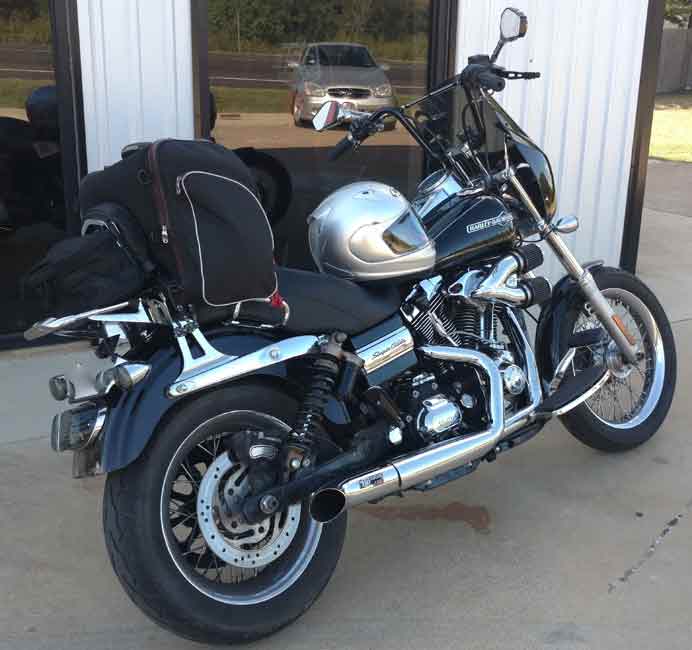
Customer writes: "Sounds like a FAST Harley! Revs quicker. Everyone that knows the bike immediately notices how the engine has better throttle response now. One blip of the throttle is all it takes to spark envy. It has a noticeable volume and powerful sound on acceleration complimented by a smooth deceleration growl. Cruising volume is somehow arguably quieter than the V&H slip-ons that were on the bike previously. The chrome is flawless. Packaging was excellent. It’s amazing how spot-on the fitment of the slip joints are. The mounting bracket is perfect in form, fit and function. Everything eases into place with a slow methodical hand. Don’t force or rush the installation and you will complete it without frustration. I bought the Dual AFR meter at the same time as the pipe. I cannot imagine an easier way to tune with my TTS MasterTune! I was able to actually improve the tune and power while maintaining 43 mpg. Thanks! Ryan"
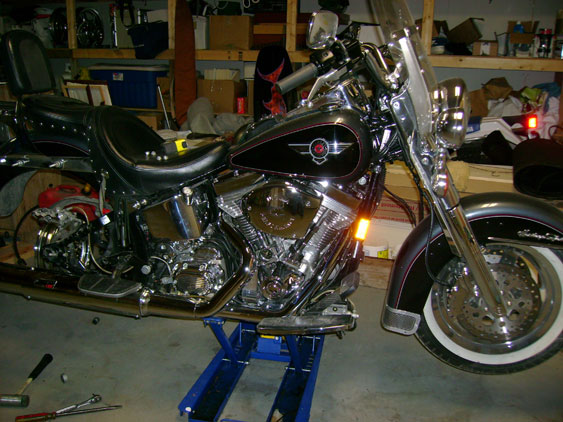
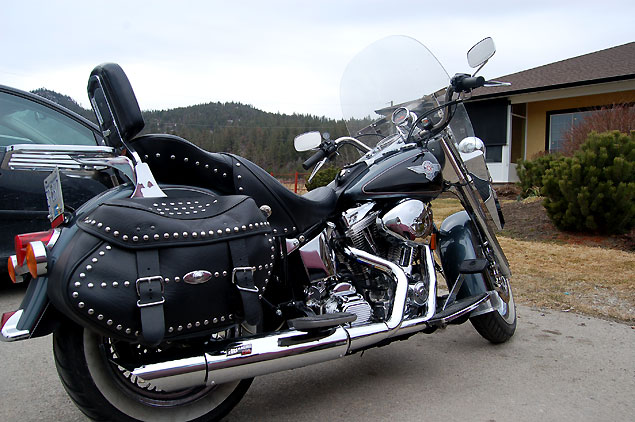
"Attached is a photo of the pipe installed, just wanted to let you know the fit and finish were excellent, at first the sound was louder than I expected but probably because I had the slash turned down, now that I have gotten used to it I really love the sound . It also improved the performance along with running smoother, the RSR fuel ratio meter made the tuning a snap. This is on a 127" very happy motor. Bob". Part Number 00-1245.
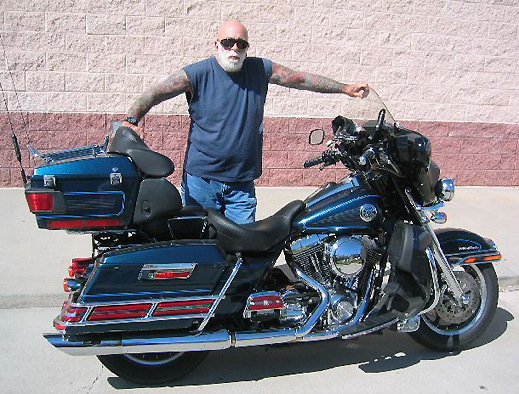
00-1236 in chrome with heat shields. Joe used the two O2 ports to dial the efi in. Tuning has to be monitored at the exhaust ports with O2 feedback. Using our RSR Air Fuel Ratio Gauge is the way to do it. Most shops are set up to "sniff" the rear of the pipe with a probe. Usually the probe goes a couple of feet, if that, into the tail pipe which puts it pretty close to atomospheric reversion (O2 rich) pulses. We prefer that the bike be monitored with O2 volatages and not probes in the exhaust.
Titanium (discontinued Finish) & Chrome
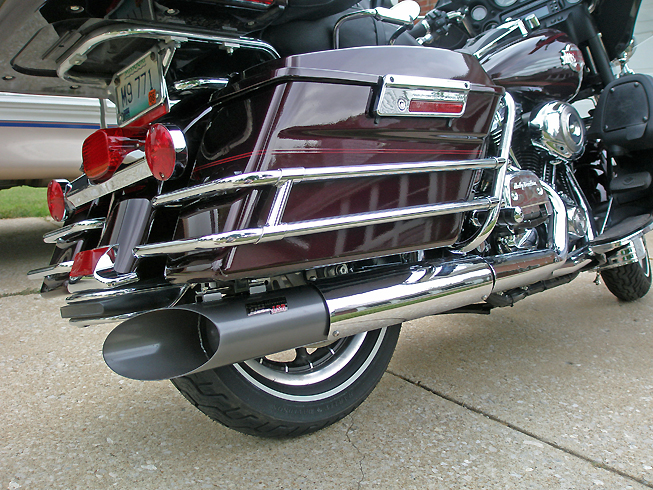
Customer writes: "Thank you so much for expressing the shipment to me. As you can see by the attached photos, have it installed. The quality of the parts and workmanship is fantastic. Installation was trouble free, great fit everywhere and very secure mounting. Only had time for a short test ride. Love the sound, its perfect. The low to mid rpm range shows torque improvement with perhaps some loss at the top end. Obviously haven't had a chance to tune the bike yet. Does have me wondering if I should have gone with the 2 inch pipes. When I get back from our trip, will try to tune it and see if that helps the top end. But I do love the sound and the looks, it is really beautiful."
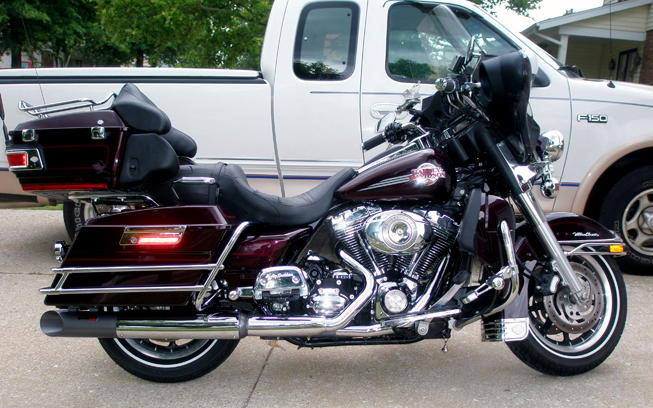
Love the titanium color of the finish. Very proud to have it on my bike. Will keep you posted on how the tuning goes. Especially thanks for all the help and your patience working with me."
00-1236 LSR 2-1 Black Hole with SS Titanium finish with chrome heat shields. Pipes usually require an adjustment of 12% for top end over stock systems. It's always the tuning. Nothing ever changes.
Note: We have
discontinued the grey Titanium Finish.
2007 Bagger
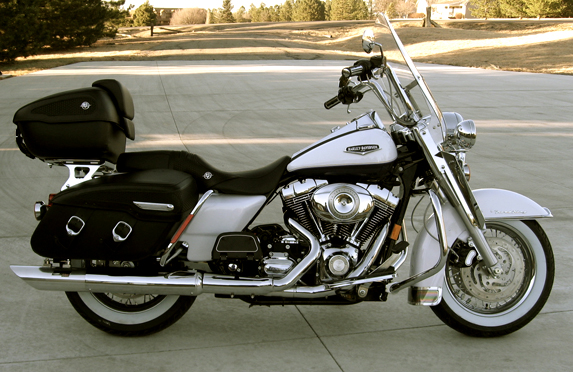
Customer Writes: "Just a note to let you know you guys make an awesome pipe. It looks great and I cannot believe how quiet it is. I have a little over 300 miles on the bike and the pipes are still silver, no blue. The silver ceramic coating looks great. I have a 113" motor and you would never know it by listening to the exhaust. Even the Dealer who installed it couldn't believe it was that quiet. I haven't had a chance to dyno it yet, but I will send you the results when I do. Keep up the good work."
00-1239 in silver ceramic with chrome heat shields. 2" primaries with chrome heat shields.
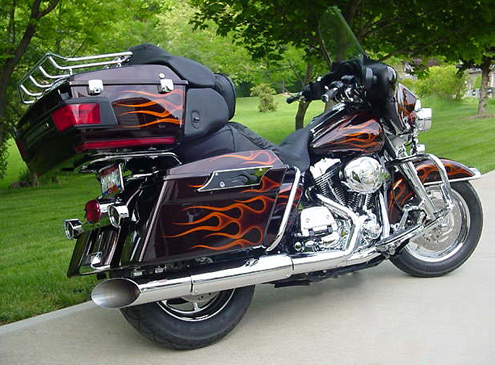
Customer writes; "You know, as much of a wise ass as you are, with a real dry sense of humor, you do make a good product. I have installed the pipes, had to make a few modifications for the rear O2 Sensor, and took it for a ride. The fit, finish is very good, and the sound is excellent. Just what I was looking for. The Daytona TwinTech Tuner made the necessary adjustments to keep the A/F where it belonged as it did change quite a bit through the rpm range. I also had to richen up the fuel "adder" a bit when starting cold. I informed you of the O2 bung mods that you might save yourself some future complaints, and the other issue is that the front bolt connecting the muffler to the mount that is bolted to the trans hits the frame, so I had to shim things a bit."
2007 Model with 00-1236 system. It's all how you tighten things up. We sort of find it amusing that people buy new bikes and then throw away the sophisticated Delphi system. Guess people just want answers and not knowledge.
2007 117"
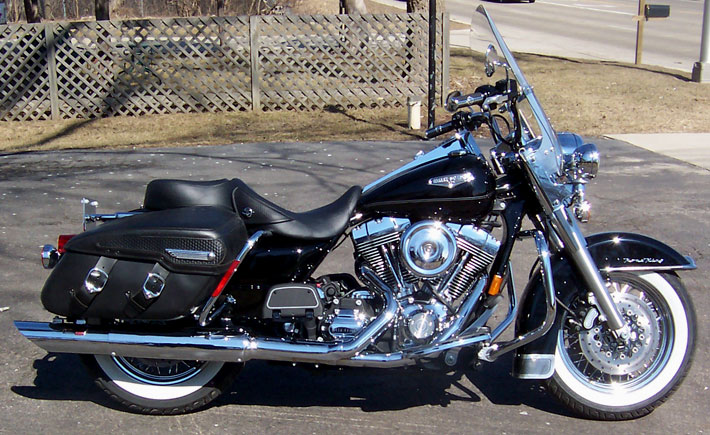
117" engine with 2" LSR 2-1 Black Hole. First off, they don't come with enough power so you put in a bigger engine. Then when you're out hunting Goldwings you get beat to death by your loud exhaust so you spend more money and buy a LSR 2-1 Black Hole System. Well, the poor Goldwing owner was stuck with his electric refrigerator and you have a hot rod, quiet motorcycle that still sounds like a motorcycle.
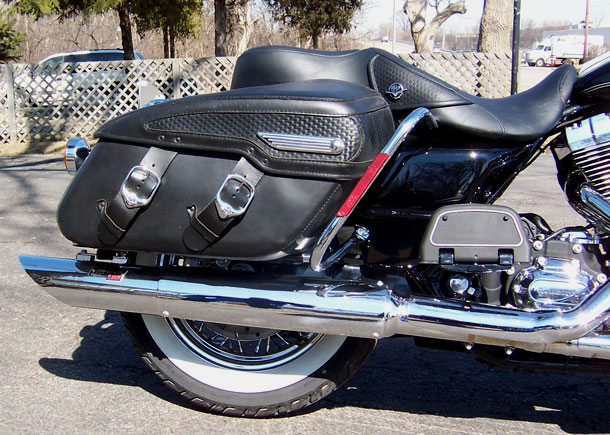
When you're hooked over smoking those Goldwings at least we gave you enough ground clearance. They are not used to quiet, rumbling, Harleys passing them...Only passing loud Harleys and putting distance from them.
Many Miles Later
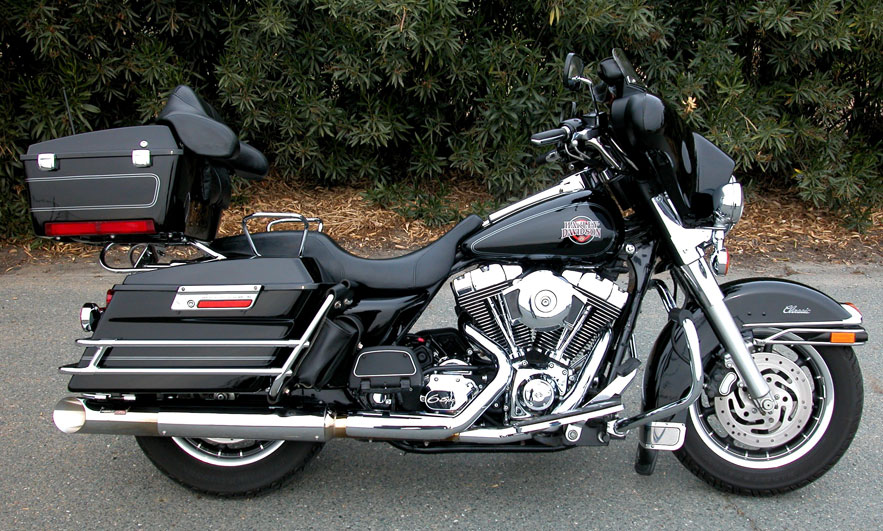
Customer writes: "Attached is a picture of my geezer glide and Blackhole exhaust. I have 39025 miles and one wreck on the exhaust (96130 miles on bike). Still looks and sounds great. This exhaust system is really a quality product. Thanks. Tom".
Basic Black
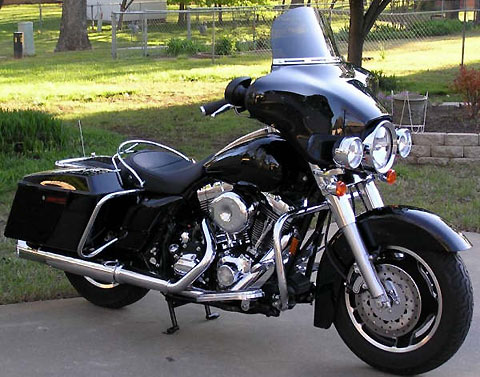
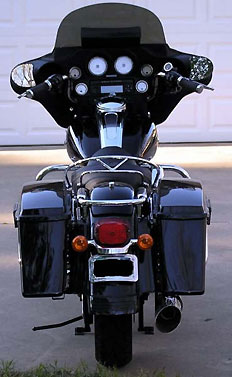
Customer writes: "I am sending pictures of the LSR Black Hole 2-1 exhaust system installed on my 07 Street Glide. Ordered Feb 5, received April 5; installed your exhaust system on the cold and rainy weekend after I received it, about 4-6 hrs of a leisure installation time throughout the weekend.
I'm glad I saw one of your exhaust systems on another touring bike before purchasing another system I was highly considering until I seen/heard yours. Thanks for the great product.
Ray"
Unrestricted Flow...Quiet Power

Black Hole Technology refutes the old saying "Noise equals Power!". The rolling thunder that cascades from a siamesed rod 45 degree V-Twin is music to our ears and provides us comfort, linking us to a past defined by the word "motor"..."motor officers", "motor maids", and "motorcycle" itself. However, every one of you who has "drilled-out" a set of stock mufflers knows that flow equals power and that stock systems, besides not being tuned, are too damn restrictive for performance.
Customer writes: "Dear RB Racing This last week we finally had a chance to do some before and after dyno runs comparing my old SE Two into One exhaust with your Black Hole 2 into 1. The short of it is that the engine picked up about 6 horsepower & 6 foot pounds of torque @ 5800 RPM. The engine configuration with the old pipe developed 74 HP & 73 to 74 Foot Pounds of torque. After the installation of your pipe the numbers were over 80 for HP & Torque. The horse power curve had not begun to flatten out @ 5800 so the HP readings could have been higher if the RPM were pushed to a higher limit."
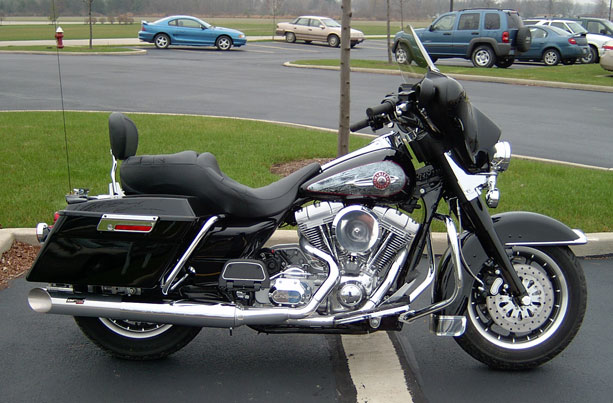
The beauty, in most cases, is that a 2-1 exhaust actually dampens the power impulses and you don't get the crackle of a set of unrestricted drag pipes. Our LSR 2-1 exhausts have a welded in baffle that doesn't hurt the flow even for a 140hp motor and they are actually fairly quiet except at full throttle and, even then, they they are quieter than drag pipes.
On a full dresser with sound-amplifying saddle bags (think drums) and sporting a windscreen and lowers that reflect noise, the picture changes somewhat...Sound does become an issue. Then there the cops and their subjective noise calls and tickets no matter what bike you have. High compression, big cams and big motors that "bark" can raise noise or sound issues. Even people who peel out of their seven car air conditoned garages on their way to their twin screw powerboats have to worry about the neighbors.
Early TC Style "C"
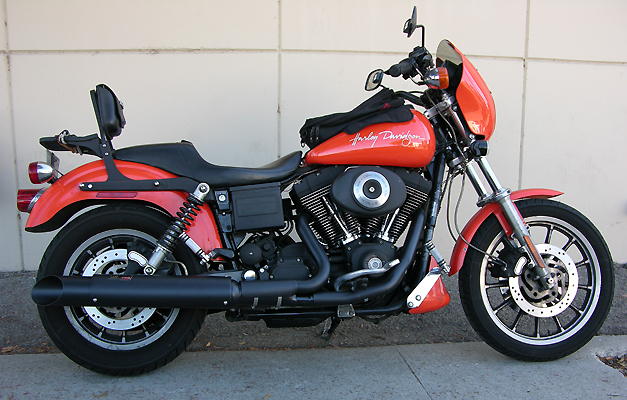
Pictured above is a TC88 Dyna with a 00-1260 LSR 2-1 Black Hole with 1 3/4" primaries and heat shields in black ceramic.
116" TC Road King
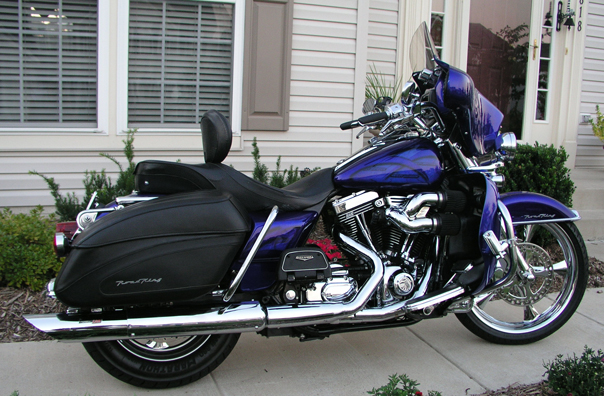
Customer Writes: "Hi guys, After much turmoil
and realizing that your spacers are not made for the
Jim/Baker 6 speed, I got the pipe installed… My setup is a
99 Road King. The only parts of the motor that are Harley
are the cam plate and oil pump. Otherwise, save for the
cams, the rest is S&S. This is 116” S&S tuned runner
injection and the S&S VFI computer.
The previous exhaust was a White Brother’s E pipe, 2-1. I just did another cam change so I won’t know how the numbers will compare once I get this newest setup tuned. The new cams are HQ 33. I am VERY impressed with the LACK of noise! I’m not kidding when I tell you my motor is louder than this exhaust. I had no idea this stroker made so clatter/induction noise… The pipes look even better than I thought they would. The power is smooth, with much less back pressure from the exhaust. Attached are a couple of pictures for you to do with whatever you like. I’m impressed!"
New Exhaust Tech Section
We have given a bit of an overview on the design of Harley Davidson exhaust systems for those who have questions about primary tube length, tube diameters, collector design and the pulsations and wave timing in a V-Twin engine.
There is also a discussion of ceramic versus chrome finishes and what are the advantages and disadvantages of these from a realistic standpoint.
Exhaust Tip Orientation
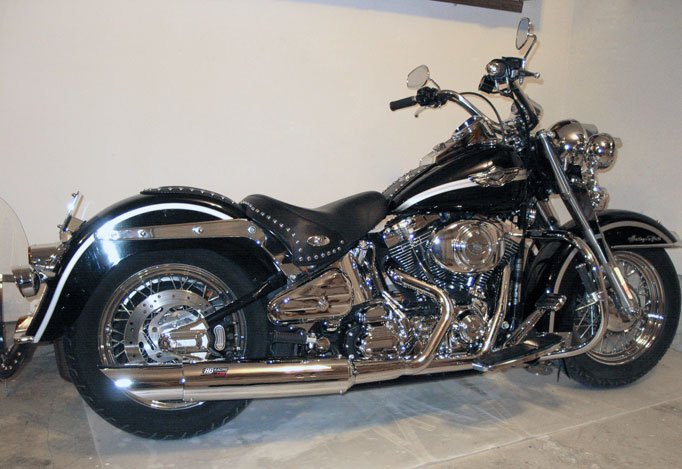
We offer a choice of the Slash Cut orientation...Either with the Slash facing outward (standard) or as in the 00-1254 LSR 2-1 Black Hole Softail system, pictured above, with the Slash rotated 90 degrees so it faces down. This is done at time of manufacture...You cannot rotate the tail section as it is welded in place.
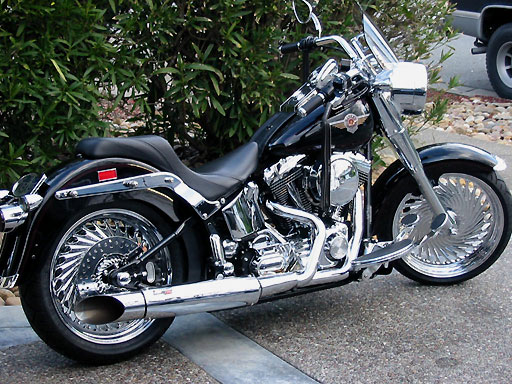
Customer writes: "Here are some pictures of the bike and the new pipe. I have only ridden the bike about one hundred and fifty miles so far. The RSR Air Fuel Ratio Meter works great. It is a little rich cruising at 70 mph...the two red lights are on, but that's the way I like to run the bike. When I cruise at 80 or above the first red flickers and last orange is on. Below 70 or lower it drops down to the orange and last yellow lights. On hard acceleration the red lights are on I have to work on that. I have four or five maps ready to go. I can't wait until March! The sound of the pipe is just awesome, to me the best sounding pipe out there. It did turn some heads." Chuck.
00-1254 LSR 2-1 Black Hole C Style with heat shields in chrome. Normal orientation of the +5" slash.
Leap of Faith
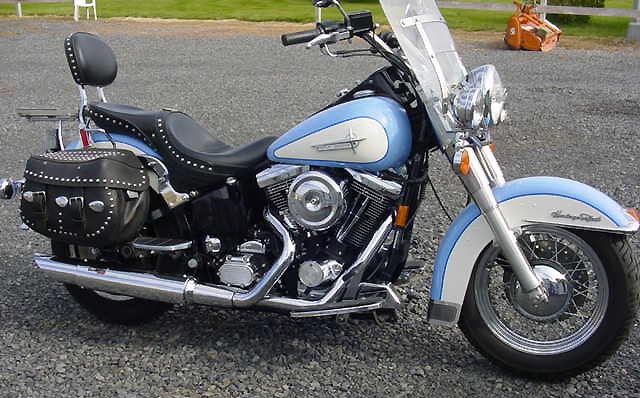
Customer writes: "Thanks RB Racing, Quality takes time, and time is money. I spent the big dollars expecting to receive the best pipe on the market. No regrets. Our Screaming Eagle exhaust was simply noise. Your pipe has a deep rich tone. Refreshing! Included is a pic of our bike. It has a six gallon tank, Corbin seat, S.E. heads, 42 Mikuni carb, EV 27 cam, Single fire ignition and adjustable push rods. Tanks, fenders and oil tank were painted in my shop. And check out that shiny new pipe! Simply beautiful. Thanks again for a Quality product.
Also, thank you for the technical assistance you gave me regarding jetting. I dropped down from a 175 to a 165 main jet and now the bike will pull to 95 mph rapidly, then at a more gradual rate it will break the ton in forth gear. The big surprise was the increase in mid-range. Before the bike would pass the ton in fourth, but fifth being a tall overdrive could not maintain speeds over 95 mph. I could run above 100, shift to fifth which would drop speed to about 95 before being able to maintain speed. With your new pipe I rode to the ton in forth, shifted to fifth and picked up three more mph. With more straight road I believe it would have continued to climb, albeit slowly. Proof that the real world rpm range has been enhanced significantly. Well I'm glad the jetting session is over. 100+ on a 1995 Softail is simply fast enough. It is good to know that when my wife and I are touring and find ourselves behind a motorhome pulling a grade that we have ample acceleration to swiftly pass. I don't miss the racket produced by our Screaming eagle pipes at all.Your Black Hole exhaust made our softtail a truly enjoyable ride.
Thanks again for the quality product, and the courteous and knowledgeable tech, support."
00-1254 LSR 2-1 Black Hole, 1 3/4" with heat shields and Slash Cut oriented "down". A clean, practical bike with a lot of custom traditional touches. A nice bike to cover some serious miles with enough power to stay ahead of the flow.
Nothing escapes a Black Hole, not even light.
We had a lot of dealings with members of the motorcycle
press over the years and like shooting stars they flame out
after a few years with few exceptions.
One individual who has survived forever told
us in the mid 90's that his magazine, now since sold a few
times, although like the cockroach he still remains employed
there, "Was sick of aftermarket exhausts that were too loud
and...that they weren't testing any fkkking loud pipes!"
That was sort of a challenge to us and it ringed true
because we knew the relationship between sound and power and
how everytime we made the exhausts quiet with our louvered
and perforated cores, surrounded by nasty fiberglass, power
fell off.
Therein lies the challenge and the story. The
loud sound goes in but loud doesn't come out.
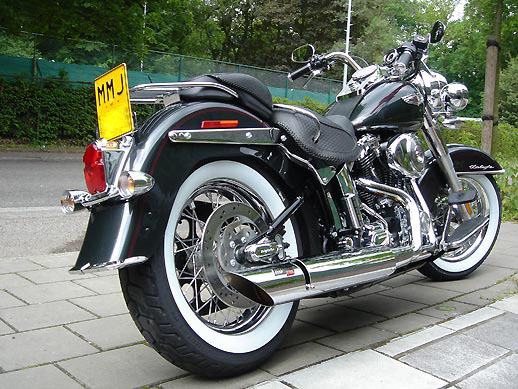
Customer writes: "Hi RB Racing, Some pics from Belgium. Your equipment is great stuff and would share the following:
1. You can really feel the increase in power.
2. The bike feels also lighter than with the original twin
exhaust.
3. Looks pretty and sexy.
Our company is dealing in acoustical engineering and we were surprised that the noise level at rpm 2300 and up is very quiet. Kind regards."
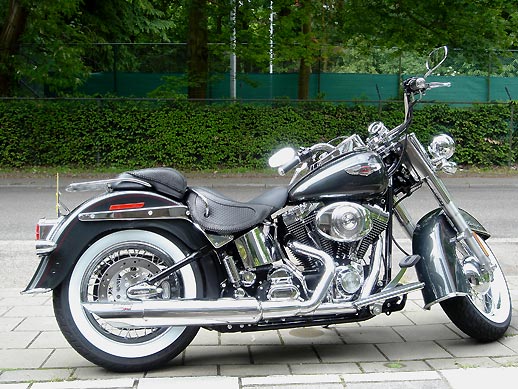
00-1254 LSR 2-1 Black Hole for a Softail TC88. Chrome with heat shields. Rear of pipe is slighly positive to the lower frame rails but still clears all accessory bags.
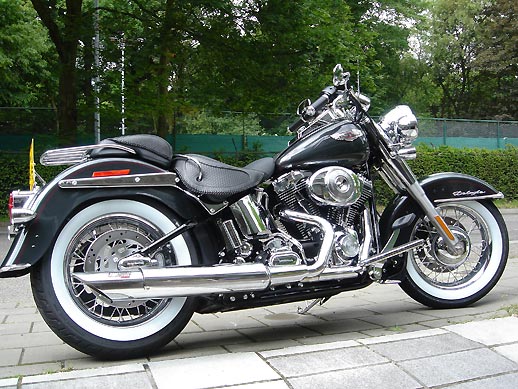
Tip orientation can be either facing outward or down as shown here. All LSR 2-1 Black Holes are built to order so you have a choice in this regard.
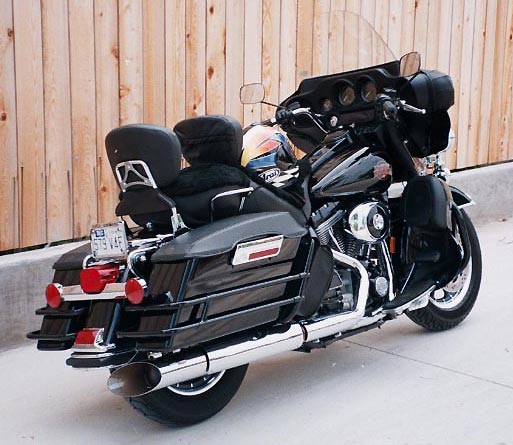
BOB & LYNN,
ATTACHED ARE SIX (6) SLIDE SHOW PHOTOS, AS PROMISED, OF MY
2004 FLHT HARLEY-DAVIDSON WITH THE NEW BLACK HOLE EXHAUST. I
WANTED TO LET YOU KNOW HOW COMPLETELY SATISFIED I AM WITH THE
EXHAUST. FIRST OFF, THERE WERE NO SHORTCOMINGS - THE EXHAUST
EXCEEDED YOUR REPRESENTATIONS. I WILL ADMIT THE PRICE
CONCERNED ME AT FIRST, BUT AFTER SPEAKING TO BOB AND LISTENING
TO HIM TALK ABOUT THE EFFORT AND THOUGHT THAT WENT INTO THE
DEVELOPMENT OF THE BLACK HOLE EXHAUST I MADE THE LEAP AND
ORDERED A SET. FROM THAT POINT I WAS DEALING PRIMARILY WITH
LYNN, WHO WAS VERY INFORMATIVE AND ACCURATE IN HER ESTIMATES
ON THE TIME I WOULD RECEIVE THE EXHAUST. (I WAS FORTUNATE TO
CATCH YOU AS YOU WERE STARTING A NEW RUN OF THE SYSTEM FOR MY
BIKE)
THE QUALITY OF WORKMANSHIP, MATERIALS, AND FIT OF THE EXHAUST
IS EXCELLENT. (BOB RECOMMENDED FOR MY PERSONAL NEEDS TO GO
WITH THE CHROME) IT IS BEAUTIFUL. THE WAY THE HEADER PIPES
MATES UP TO THE CYLINDER HEAD PORT IS LIKE NO EXHAUST I HAVE
EVER SEEN. THE MACHINE WORK IN CONJUNCTION WITH YOUR BILLET
GASKET MAKES FOR A PERFECT MATCH FROM CYLINDER PORT TO EXHAUST
MANIFOLD.
NOW, FOR THE REASON I PURCHASED THE BLACK HOLE, "THE SOUND".
FROM PRIOR EXPERIENCE WITH 2-INTO-1 EXHAUST, IN TERMS OF
INCREASED POWER AND SMOOTHER OPERATION, I'M CONVINCED IT'S THE
BEST WAY TO GO, BUT THE TRADE-OFF IS "EXTREME NOISE", MAKING
FOR AN UNCOMFORTABLE AND TIRING RIDE ON 300-600 MILES A DAY.
PROBABLY 98% OF THE TIME I RIDE DOUBLE WITH MY WIFE AS A
PASSENGER. SHE HAS ALWAYS COMPLAINED OF HER EARS RINGING AFTER
OUR RIDES. THE EXPERTS CLAIM IF YOUR EARS ARE RINGING YOU ARE
LOSING HEARING. I HAVE BEEN AROUND PEOPLE WHO ARE DEAF, NOT A
GOOD TRADE-OFF FOR POWER, AND EAR PLUGS ARE ANNOYING AND MAKE
IT IMPOSSIBLE TO USE OUR AUTOCOM SYSTEM. THE PROPOSED
SOLUTIONS I HAVE ENCOUNTERED WITH OTHER BRANDS ARE MORE
RESTRICTIVE BAFFLING AND LESS POWER. NOT A GOOD SOLUTION. WHY
CHANGE EXHAUST? THEN I HEARD OF RB RACING AND THEIR BLACK HOLE
EXHAUST. I WENT ON-LINE, FOUND YOUR VERY INFORMATIVE WEBSITE
AND DECIDED TO CALL AND POSSIBLY ORDER A SET. BEST DECISION I
EVER MADE. THE POWER IS EQUAL OR POSSIBLY SUPERIOR TO THE
2-INTO-1 SYSTEM I HAD RUN (WHICH WERE TOO HOT AND TOO LOUD).
THE SOUND IS PERFECT, DEEP AND THROATY AT IDLE AND LOW SPEED,
A LOW FREQUENCY RUMBLE AT HIGHWAY SPEED, NOT ANNOYING, ABLE TO
HAVE CONVERSATION WITH WIFE WITHOUT YELLING TO BE HEARD AND
STRAINING TO HEAR. WE HAVE BEEN ON 3 RIDES OF APPROXIMATELY
400 MILES EACH AND MY WIFE SAYS NOT ONLY DO HER EARS NOT RING
AFTER THE DAY'S RIDE BUT SHE FEELS MORE RELAXED AND ENJOYS THE
RIDE MORE. WHEN I READ OTHER LETTERS POSTED ON YOUR WEBSITE I
WAS AFRAID THE EXHAUST WOULD BE TOO QUIET, BUT THAT IS NOT THE
CASE AT ALL. I HAVE OWNED 5 HARLEY-DAVIDSON MOTORCYCLES WITH
DIFFERENT KINDS OF EXHAUST AND I LIKE THE SOUND OF THIS
EXHAUST BETTER THAN ANY OTHERS THAT I HAVE HAD.
RB RACING BLACKHOLE EXHAUST FOR FLHT HARLEY, GOOD QUALITY
MATERIALS, EXCELLENT WORKMANSHIP, EXCELLENT POWER, PERFECT
SOUND, WHAT MORE COULD ONE ASK...BETTER FUEL ECONOMY? MY BIKE
IS A CARBURETED MODEL WITH CRUISE CONTROL. SO FAR THE MILEAGE
IS RUNNING BETWEEN 39.6 MPG, INTO A HEAD WIND, ON A HILLY
ROAD, LOTS OF UPHILL GRADES, TO 45 MPG, ON A DAY WITH CALM
WIND AND NORMAL HIGHWAY. THIS IS RUNNING 70 MPH, RIDING
DOUBLE, CRUISE CONTROL ON. I EXPECT THIS MAY BE IMPROVED WITH
A LITTLE TUNING BUT THIS IS AN HONEST 2.5 - 3 MPG IMPROVEMENT
OVER THE MILEAGE I WAS GETTING BEFORE INSTALLING THE BLACK
HOLE EXHAUST, AND ALL I DID IS BOLT THEM ON.
I APOLOGIZE FOR THE LENGTH OF THIS LETTER BUT I WANTED TO BE
SURE YOU KNOW HOW MUCH MY WIFE AND I APPRECIATE THE TIME,
THOUGHT, AND EFFORT YOU PUT INTO DEVELOPING THIS EXHAUST
SYSTEM. THE OPERATION OF THE MOTORCYCLE IS SMOOTHER, NO
STUMBLES OR COUGHS, JUST SMOOTH, EVEN TORQUE THROUGHOUT THE
ENTIRE RANGE, "TRULY PERFECTION".
THANK YOU VERY MUCH,
TOMMY JOHNSON
P.S.
EASIER TO CLEAN, WORTH EVERY PENNY!!!
We built a series of prototypes over a period
of months and got nowhere. Increasing complication involving
pre-chambers, multiple internal cores, reflecting cones,
angled planes etc. just didn't work at all. It was the same
old problem, decreased noise meant increased backpressure
and increased complication meant increased size. Graft on a
large car muffler from a big V8 and there were positive
gains in noise reduction and backpressure readings but you
ended up with an aesthetic disaster. We hit the wall.
Nowhere to go except back to a blank sheet of paper, Ashlar Graphite and a calculator. The answer is always hiding in the math and that's where we found our answer. The solution is always elegant and simple. It only took us 17 years to find it. Define the problem mathematically and the arrow points to a solution.

LSR 2-1's Bonneville,Dyno &Track Proven
If you want to make power on a multi-cylinder
engine you have to use a collector system. Whether it's a V-Twin
or a V-8 it's the same... Not using free exhaust energy to help
your engine breathe is downright criminal. No matter what the
conventional wisdom is, staggered duals on a Harley will not
make more power.
You simply cannot escape the fact that a properly designed 2-1 will give you more useable torque where you need it, in the 2000 to 4000 rpm range, which means less downshifts and less rpm to get the job done. A set of short staggered duals at peak rpm can be made to produce good power but they will be dead on their ass until they get there, whereas an engine developed around an LSR 2-1 exhaust can be made to perform from the bottom up with no dips in the torque band!
Baffling Alien Discs and
Aluminum Butt Plugs 
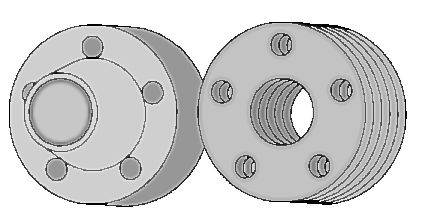
Our testing has shown that the Harley V-Twin is
extremely sensitive to back pressure which is why 2-1's that use
small or restrictive collectors don't breathe well, and why restrictive
baffles shut the motor down.
Disc type baffles are good for spark arrestors on
dirt bikes but they have no place on a big inch V-Twin. You
don't make power by adding restrictions to your exhaust system
whether it's a bunch of stainless discs or some damn piece of
aluminum billet machined into a Harley butt plug! Ever wonder
why they had to put a hole up the center of the discs? Well, one
reason was the discs are so damn restrictive you have to have
several pounds of them to get enough flow through their waffle
shaped passages. Good mufflers, but they have nothing to do with
performance and they sure as hell do not create vacuum as has
been claimed.
When you get confused by all the bullshit simply ask the following question.." Do they run them in NASCAR or in Formula One?". Nope, they run straight pipe collector systems without any stupid discs or aluminum butt plugs.It's always funny how when the money is on the line, all the little things like discs, billet caps, anti-reversion flaps, reverse megaphones and other such nonsense somehow don't make the field. Black Hole technology does not involve stupid eye candy or outdated, or just pain dumb ginger bread.
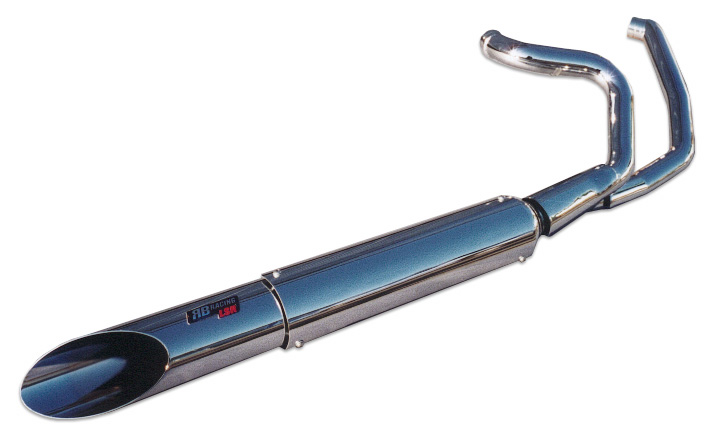
This is the business end of a LSR Black Hole 2-1 system. Massive four inch Slash Cut tail section with heat shield. Pictured above is our LSR 2-1 Black Hole, 1 3/4", C Style, Plus 10", TC88, FLHT. Part Number 00-1236.
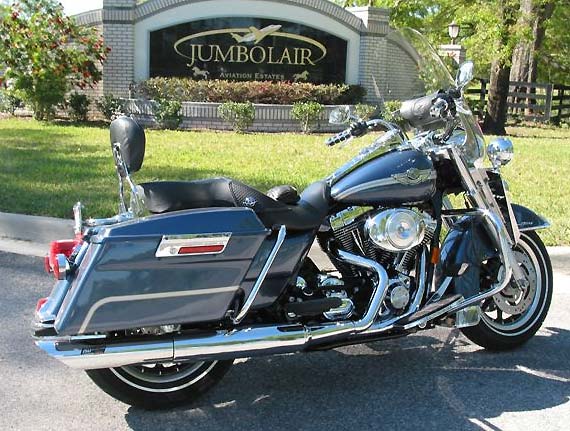
The sound our LSR 2-1's make is so "right" that customers want them for their sound alone. They have a much more powerful sound because the engine is working easier and the power is much smoother. Our regular LSR 2-1s wound out to the max get everyone's attention because they sing the song that only a power junkie would love...Well, maybe not everybody! Bike gets 47.8 mpg @ 60 mph with a CV Carb.
Customer writes " My neighbors hated my Pro Pipe and the noise was unbearable pulling a trailer. When I put on the Black Hole my neighbors came over to tell me how wonderful my Harley sounds...they wanted to know what I had done. I can now hear my radio and my wife is happy. As a bonus, my plugs cleaned up and I just love the sound. I had my friend drive my bike by just so I could listen to it!"
Quiet Power
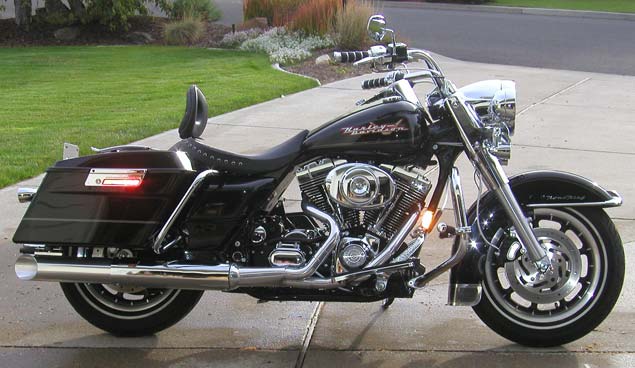
Customer writes: "Thanks for everything. I put the pipe on and it is incredible. I have so much more power now. I had Andrews TW26G cams put on my bike some time ago, but they never performed the way that they were suppose to when I had the stock manifold and Hooker pipes on it. Now it has good torque all across the RPM spectrum. Also, I don't have to worry about waking the neighbors on Sunday morning."
Customer Writes
"First, thanks Bob for having the patience of a
saint. The Blackhole exhaust is expensive but compared to
what. It took a lot of convincing for me to risk the money. I
have no regrets and if I had to buy a new exhaust I would
invest in this one again. I ride an 03 Ultra Classic EFI with
the standard big bore and mild cam all from Harley. We pull a
trailer and did an 8100 mile trip covering most of the mid to
upper states from Mich to Cal. At the time I was running a
Vance and Hines 2 into 1 Pro, I loved the power it gave me and
for the most part I loved the noise, my neighbors thought it
sounded just plain loud.
Back to my trip and why I had to find a new
exhaust. If you pull a trailer you will understand. At the end
of the day, a short day if it was all in the Rockies our heads
felt like mush and when we stopped had to literally hold on to
the bike for a minute to get our feet and head to agree it was
O.K to be upright. The exhaust bouncing off the trailer
rattled our brains that bad. After a friend told us about the
Black Hole (Thanks Richie) and reading all the literature and
I apologize again Bob for beating you up so bad over the
phone, I bought one. I was worried that I wouldn't like the
sound, I was scared to death I would loose power and I hoped
like hell I could run with my trailer at speeds up to at least
80mph without my head getting the crap kicked out of it.
The long and short of it is, it sounds great, my
neighbors all love the low rumble and tell us over and over it
sounds like a Harley should, understand these are Harley fans
not neighbors that think all bikes should sound like a
Goldwing. Power I have, I notice very little difference
between the Black Hole and my Vance and Hines. Pulling my
trailer is heaven, we notice little to no difference in noise
level, with or without the trailer behind us even at speeds of
80mph. I turn more heads now than before with this exhaust in
town and while turning on the power cruising on the Highway.
This exhaust was bolted on and nothing else was done to the bike, it was set up for a 2 into 1 exhaust. The long and short of it is that this exhaust does what it says. It is a little louder than I expected at idle but the low rumble is not unpleasant to the ears. For the first time since I took off my Stock mufflers we can talk to each other at normal voice levels and listen to our radio without the volume cranked up no matter what speed. The only complaint I really have is that I bought the Ceramic coat, it scratches real easy while installing the shields if I had to do it over I would have ordered the chrome. Roland and Karen"
We sent him a chrome one.
Customer Writes
Customer writes: " Just installed my new LSR 2-1 Blackhole Exhaust on my 2002 Ultra Classic HOLY SHIT !!!!!!!!! So yea I went to the Shit Head Dyno Again. Before 77.2 hp 78.7.6 lbs @5200 Now 90.4 93.1 @5500. WOW Fuck the slip ons! I dont want any racing SHIT in this one I want to keep it a stock Twin cam 88. I take the QUEEN riding on this one. It makes plenty of power. Thank You once again. Ed "
95"
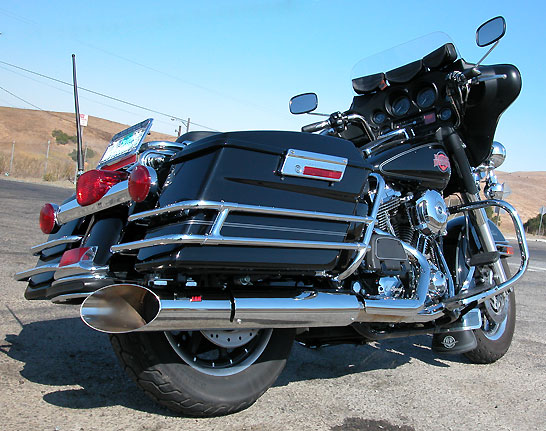
Harleys are all over the map...88/95/103/117/124/126 etc. Now in 2007 they have gone 96/110. Here's a nice 95" with a 00-1236 LSR 2-1 Black Hole Exhaust.
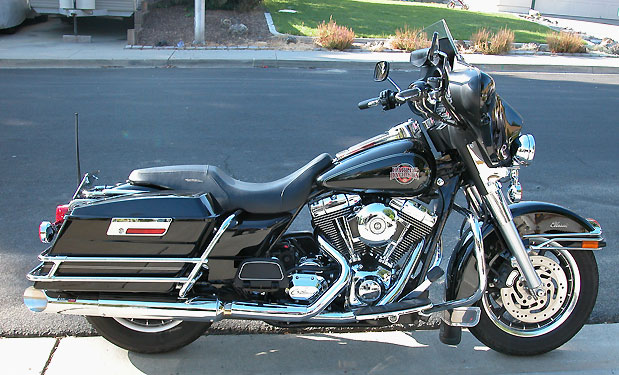
Customer writes: " I want to thank you for a good looking, exquisitely fabricated, great sounding, perfectly fitting performance exhaust system.
I installed the system a week ago with 58,271 miles on my bike. I removed a stock system with SE performance slip-ons. The difference is that now I have more torque, accelerates faster, runs cooler, looks great and don't set off car alarms. I now have 58,125 miles on the bike. Love to ride. Enjoy being able to go fast without being noticed (loud).
The bike is a 2004 Electra Glide Classic with a 95" kit, stock heads, crane cam with gear drive.
Attached are pictures of my "Geezer Glide" (I'll be 60 next month).
Thanks Again,Tom"
Power and Performance
Everyday we talk to customers who have tried every pipe on the market and can't believe how much faster the LSR 2-1 is throughout the RPM range. You can expect horsepower gains from 6 to 20 hp over any other design. On the sound issue, we keep getting asked what a particular pipe sounds like, to which our answer is "It still sounds like a Harley." We periodically, over the last 25 years, would hear from a particular customer that with his motor combination the LSR 2-1 was "loud" when he "got it on!"....This is to be expected...Or at least it used to be until the LSR Black Hole 2-1 came along.
The LSR Black Hole technology takes the "potato, potato, potato" sound that Harley tried to patent a few years ago and keeps it in check when you twist your scooter out to redline. You still get the throaty "potato, potato, potato" sound but we found a way to cut the noise by a factor of two when you're cruising or hitting redline.
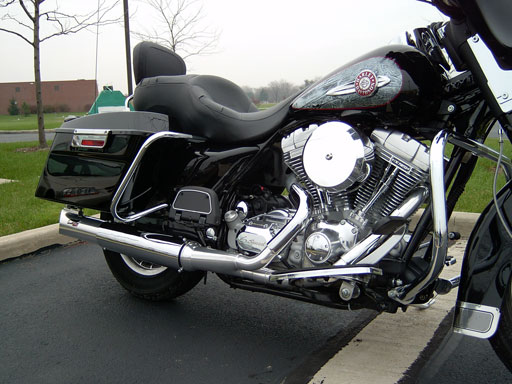
Pictured above is our LSR 2-1 Black Hole, 1 3/4", C Style, Silver Ceramic, Plus 10", TC88, FLHT. Part Number 00-1236. Bike is a 95" TC88. Pipe was transferred from another TC88 FL after 13,000 miles to the newer model with increased displacement. Customer states... " I love the sound. It is perfect! Throaty, but quietly powerful sounding, at idle and slow speeds and at a 3000 rpm cruise I can ride all day!"
LSR Black Hole 2-1 exhausts are available in two lengths: Plus 10" and Plus 5". The length is referenced to our normal LSR 2-1 Slash Cut exhaust system length. The Black Hole Technology requires at least five additional inches in length and a four inch diameter tail section (same as oem Harley muffler) to cancel the sound. Our regular LSR 2-1 exhausts use a three inch diameter tail section. FLH/T Road King Series are all Plus10" length so the oem under bag mount can be used.
360,000+ Miles
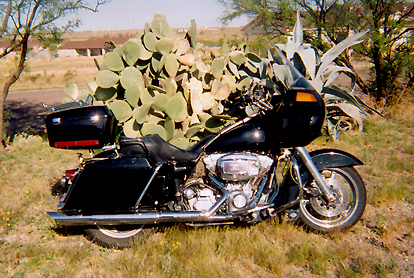
Jon stops by our shop with his special FL. 17" wheels and tires. Stock TC88 engine and somewhere short of 400,000 miles on the chassis. Second engine. He called later and said he's had the bike up to 115. We don't think he owns a trailer.
Mystery to Us
Customer Writes: "Bill G. here from VA. Your past help as been great to point me in the right direction. I am the guy who thought the Black Hole was too loud. Good news on my Black Hole system which I can not really explain. A couple of weeks ago I changed the factory ECM and power commander out to a ThunderMax (Zippers) closed loop system with their ECM. Set up was simple and the auto tune worked great. The surprise is when I pulled in the driveway at home for the first time with the ThunderMax my wife came out to ask me what I had done to the bike as it was very noticeably quieter. I noticed this too on the way home from the shop. I just returned from Daytona Bike week and am happy to report the Black Hole works just as you said it would. Sounds great. Not too loud at idle and sounds quieter the faster I ride.
The change from stock ECM and removal of the power commander had something to do with it. I had the bike dyno tuned with the power commander and it seemed to run with good torque and power. I did notice that at some throttle positions it was better than others. The tuner did the dyno at 1000 rpm steps. My bike is an 05 Ultra with 1550 cylinders, screamin eagle heads, Andrews tw21 cam, Harley standard throttle body and Arlen Ness big sucker air box. And of course the Black Hole exhaust. I really liked the looks of the Black Hole system and now I am very pleased with the performance and sound. You can depend on me to recommend your Black Hole to anyone who asks."
Best Regards,
Bill G.
Hell if we know.
Self-Tuning Myth
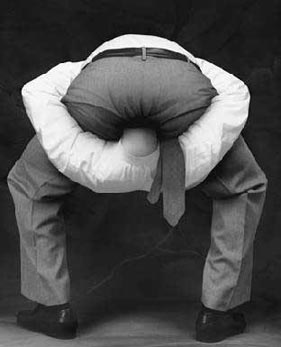
People have the idea that closed-loop systems are completely self-tuning and that they are going to sell you some add-on gizmo that will automatically tune your efi bike. This is a crock of shit. The truth is that every engine is different and, in the Harley world, difference is the norm as there are limitless engine build combinations.
In Detroit, Japan, or Germany, they spend thousands of man-hours developing base maps for their automotive applications. On top of these base maps goes the closed-loop feedback mechanism controlled by mathematical equations or algorithms that govern exactly how the closed loop operation will function. These base maps are not written so the vehicle will run perfectly without feedback i.e. maps are not designed for open-loop operation. The strategy for closed-loop operation is different as fuel requirements under different climatic and altitude differences can be as much as 30%. Unless the base map is constructed for the particular application, the O2 feedback mechanism will not work properly.
OEM correction schemes allow only very slight learning corrections or they will "throw" an error code. They do this for a very specific reason i.e. if things are going wrong, which is indicated by the system trying to correct out of bounds problems, then a sensor or something else is wrong. They are not designed to make large swings to correct calibrations that are way out of bounds.
Beyond Stupid
Some add-on boxes for late model O2 sensor equipped oem Harleys eliminate the O2 sensors altogether. Why in the hell would you want to take a self-adjusting, sophisticated system and turn it into a gas guzzling low mileage dumb efi system? Beats the hell out of us and, since we make closed loop efi systems, we do have some experience in this area.
You bike should be left in closed loop, tuned in closed loop and monitored with O2 displays in closed loop. Correction factors defined in the oem code cannot be exceeded. Maps have to be rewritten for the changes to the bike so thje base map is in agreement with the oem algorithms.
Phone Sex and Remote Tuning
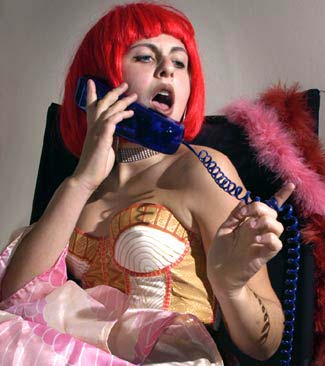
In some sort of logical disconnect a few customers call us up wanting us to tune their bike over the phone and then become increasingly indignant when we tell them it just doesn't work that way. Now, we spent the better part of 14 years, starting in 1976 working on carburetors, jetting, needle design, and even designed and marketed a flat slide carb for the Harley market. Thousands of man hours representing about 5 months out of every year were devoted to jetting issues. It got to be a real issue i.e. it was an interesting experience to define what the correct air fuel ratios should be, experimentally figure out how to measure them, and then deal with tuning die cast critters, often modifying them with extra circuits etc. but, in the end, it was temporal and an endless loop that did not exactly pay the bills.
We did learn how to make things run well, not that anyone appreciated it. It was fun to watch people try to beat you when they couldn't. Knowledge. Hard work.
For the last 18 years we've been working on and manufacturing closed loop fuel injections systems for Harley Davidsons and have set numerous Bonneville, El Mirage and Maxton speed records and won drag racing championships with them. We spent over 3000 man hours writing and perfecting Autocal.V6 prediction and analysis software for our RSR Fuel Injection systems. Why did we spend 3000 man hours? Well, we didn't plan on it, and it's a good way to flirt with insanity, but we saw no other option as digital efi requires hundreds of decisions, all of which are intertwined. No more brass jets. Exponential combinations. Changing points, one at a time is sheer insanity. Progress comes with increased complexity.
These days all Harleys are closed loop fuel injected with a single throat throtttle body and are speed density Delphi systems, all very complex. It's the same formula we decided on 18 years ago. The only thing we suggest is that you use O2 signals to monitor and tune the system as the sensors are millisecond accurate and must be monitored at the exhaust port where temperatures are high and as far away from the outside oxygen rich air as possible. We suggest you use software, not hardware, to adjust your system using our RSR Air Fuel Ratio Gauges and keep your bike off of the dyno until the lights in these displays tell you your mixture is correct. Engines operate in a very narrow realm of air fuel ratios. If you want to go to the dyno after this...fine.
Just don't call us breathlessly demanding we tune your bike over the phone.
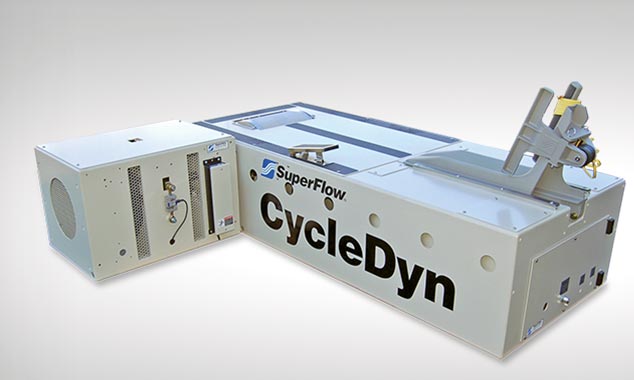
If you are going to use a chassis dyno it has to be a tool and not a toy. At RB Racing we use the Superflow CycleDyn as it best emulates the real world. We use it for development and not for publishing "dyno charts". Most of our work is with Pectel SQ6M controllers which have extensive internal datalogging and playback capabilities up to 2000Hz sampling rates. With the Superflow we can program specific tests and transient sweeps with our turbocharger systems up 750 hp in inertial mode or 500 hp in Eddy Current controlled accelerations.
For those of you who
like Dynojet "Dyno Graphs"..read
this article.
Steve Cole (TTS MasterTune) who has spent untold thousands of hours on every dyno imagineable has this to say about CycleDyns:
Steve Cole: "In the
development side what I can say is the SuperFlow when setup
properly emulates the real world much better. As an example
the only way to get a DynoJet to give you HP and TQ is a WOT
unloaded run. The SuperFlow allows that plus just about any
other combination you like with real torque output. So what
does any of it buy you becomes the question. I can tell you
that if we tune to a DJ and get the best we can, then repeat
on the SuperFlow using real world acceleration rates for the
engine being tested the results are very different. Take the
final calibrations and run them in both dyno's unloaded and
the DJ developed type calibration will show the most HP and
TQ in those conditions, on both the SuperFlow in DJ mode and
the DJ. Then take the SuperFlow controlled condition
calibration and load it in the bike the power will go up
when tested in the SuperFlow mode again which can only be
done on the SuperFlow.
Now the hooker, take the bike and put one of the finished
calibrations in it and give it to the customer and say go
ride it and come back after you've ridden it well, to know
how it feels/runs. They come back after an hour or so then
load the other calibration and ask them to do the same
riding over and come back again. Each and everytime we have
done this every customer has picked the calibration that was
done on the SuperFlow under the controlled acceleration
modes! So pick what works for you but there is a difference.
Does it take longer, does it end with a measurable
difference............. YEP!"
When we have turbo
bikes like our Road Glide Turbo
it gets a bit interesting to go testing in LA traffic with
police, cell phone cameras, and freeway cameras. We still do
real world riding with data acquisition as the real world is
where you ride.
People want "Dyno Sheets"...see below. We aren't going to test every damn camshaft, compression ratio, piston confguration, cylinder head etc as there is not enough money nor time to do so. However, we do testing for our own race development, R&D, and our personal development platforms.
Dyno Sheets

People call us all
the time asking for "Dyno Sheets" and we patiently tell them
we do not provide self-serving graphs predicting fantastic
horsepower and torque gains. Plenty of customers send us
dyno sheets but, as we've been at this a long time, we know
the tuning game is too complicated to provide numbers just
to sell an exhaust. Tuning is a multi-variable process.
When the EVO motors came out Jerry Branch published his famous manifesto on tuning 80" EVO motors...In short, unless you bumped the compression the horsepower was not forthcoming. Same these days. In 2014 John O'Keefe of Branch O'Keefe ran an extensive series of tests on OEM Twin Cam cylinder heads to see if he could offer a "less expensive" ported head as everyone with a grinder in his garage was suddenly an expert at cylinder head porting. John found out that any attempt to clean up the ports killed the flow and port velocities dropped. He scrapped that idea and kept his well-proven chamber modification, porting and valve replacement system.
Logic seems to be in
short supply when it comes to tuning. Tuning is not a pipe
changing exercise. The world these days is full of customers
who agonize endlessly over what to buy and then dump these
parts on some unsuspecting "shop-tuner" expecting miracles.
It just isn't going to happen. Coordinated development is
expensive and time consuming. If it was NASCAR developer
they might spend days searching for a few hp or a different
curve for a specific track.
If you are looking for warm cuddily sheets we are clean out of them. We are tuners and you can buy all the trick parts in the world and a guy with a well tuned mild bike with a good power to weight ratio will kick your ass. Real world. Find a good tuner or become one. Look in the mirror.
Torque and Ruby Slippers
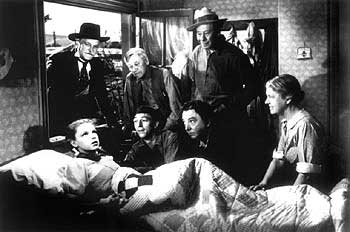
People get pissed at us when they ask for "numbers". We always tell them we "don't know" because after nearly 33 years of tuning and racing and designing we have seen too much and done too much to give any placebo answer. In fact it always depends on the bike and the tuner. No two bikes are alike. Maybe your bike was built on a Monday and they left a coke bottle in the gas tank (old Detroit wive's tale)...Some bikes are faster than others. Everyone believes their bike is "faster". It depends on the tuner and, these days, the bikes are more complicated. People change from chain to gear drives. They put on different cylinder heads. They switch cams. They add on tuning twiddle boxes. They tune, or the "shop" tunes. They "dyno" the bike...maybe even somebody rides the bike with instrumentation like our RSR Air Fuel Ratio Gauge.
People call us up then hang up when we tell them we don't know what their "gains" will be. We don't publish self-serving charts. We just take all the experience we have and build the best parts we can. People end up happy who buy the parts because they are well made and are designed to perform. We make different tube diameters and offer a wide range of systems for any particular bike so you will maximize your potential. There is no "One Size Fits All" at RB Racing.
People who don't buy the parts because we won't coddle them with assurances go elsewhere where Aunt Em will tuck them in and tell them what they want to hear.
Note: All LSR exhausts require the use of the OEM flanges and circlips. The Harley part numbers for these flanges and clips are: 65328-83 (exhaust ring clamp) and 65325-83A (retaining ring). S&S Cycle SA or B2 (145" Tribute) cylinder heads require four bolt flanges which we provide and are part of the pipe assembly captured by or Special Application Venturies.
FXR: There are FXRs and then there are aftermarket FXRs like Kenny Boyce frames and a variety of "Rubber Mounted" pro street and quasi-Softail designs. For all of these we provide a 1/4" steel plate that bolts to your transmission. The bracket is slotted to allow for variations in engine mounting and has a selection of dowels that take into account the different transmissions available. The bracket attaches directly to the back of the LSR 2-1 pipe, which has a slotted bracket heliarced to the pipe. The bracket does not interfere with billet aluminum swingarm pivot mounts like those on Kenny Boyce frames or other aftermarket pivot mounts.
Early FXR(P) police models with floorboards don't fit many pipes. Best bet is to install forward controls or mid pegs on this particular model...then regular part numbers apply. To fit LSR 2-1s to these ex Police models with floorboards it will be necessary to cut and modify the rear floorboard support (splined peg mount to floorboard bracket) for clearance on the pipes. FXRT models had mid pegs and pose no problems.
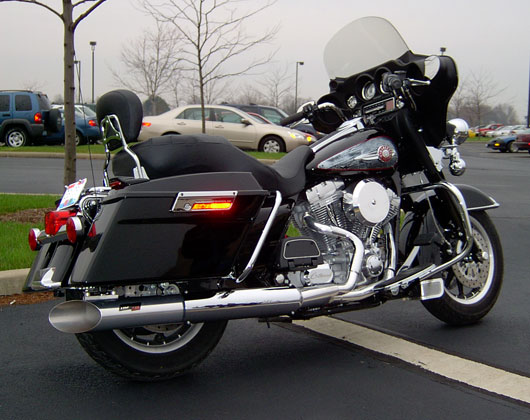
FLH/FLT/Road King Plus10": Dual mount: transmission and saddlebag. 1/4" laser cut steel plate dowel mounted to transmission. Oem rear saddle bag mount are used. Remove any oem brackets for the front pipe beneath the nose cone. If you are running a Baker 6 speed they are wider and we have to shorten the transmission mounts by 1/2".
DYNA (Evo) Plus 5": Transmission mounted. 1/4" laser cut steel plate dowel mounted. No oem brackets are used. Remove any oem brackets. 00-1281 2" C Style for a 145" S&S Tribute motor pictured.
DYNA (TC88) Plus 5": Transmission mounted. 1/4" laser cut steel plate dowel mounted. No oem brackets are used. Remove any oem brackets.
Softail (All) Plus5": Pipe bolts directly to frame via 3" wide heavy steel "Z" bracket. No oem brackets are used. Remove any oem brackets.
Evo Sportster Plus 5": Laser Cut steel bracket replaces oem bracket (all rigid mount models). On 2004 models we supply a transmission bracket that supports the mid part of the rear pipe. On 2004 and later models remove the large oem bracket which requires the removal of the rear final drive cover aft of the transmission. #30 Torx required to unhook rear brake rod. 2004 and later Rubber mounted engines require early style exhaust flanges as the 2004 flanges are too thick for our turbo venturies.
Mounting Torques
For flanges and mounts we recommend 15 foot pounds of torque. On exhaust flanges you do not use any locking compound as our nuts are self-clinching. On bolts for frame and engine-mounted brackets we recommend that the threads be clean and that a low grade (Blue) thread locking compound be used with 15 foot pounds of torque. Bolts and nuts on our slotted brackets do not require a locking compound but can also be tightened to 15 foot pounds.
In lieu of torque wrenches do not overtighten exhaust flanges to the point where they bend. In the case of bolts going into transmissions and into frames also do not attempt to see how strong you are as aluminum threads and bolts are weaker than you and your wrench are. Simply tighten things till the bolt stops and give another partial turn to firmly snug it. The last bit of tightening actually stretches things a bit and the tension holds things tight. Tightening should always be done in a sequence. Never finally tighten one part then go to the next...Always loosely tighten things in sequence and then finally tighten things in sequence.
The exhaust should never be installed with any of its elements in tension. It has to rest in place without strain and be tigtened without strain.
We employ split lockwashers on most fasteners to prevent counter-rotation. This works surprisingly well if the bolt is properly torqued or tightened.
In any case, you have a responsibility to tighten things or at least check periodically as part of your normal maintenance. Harleys do shake and try to kill anything attached to, or even near them. If things get loose the additional shaking moment can break bolts and destroy threads.
General LSR 2-1 Installation Sequence
1. Remove the OEM exhaust and exhaust bracketry. If the bike has floorboards remove the right floorboard.
2. Pry the OEM exhaust gaskets out of the exhaust ports. We use billet gaskets instead.
3. Install the frame or transmission bracket provided. Use Blue Loctite on the mounting bolt threads into the transmission. Lockwashers under the bolt heads on the transmission mount. If through-bolt like on early rigid Sportsters or Shovels use lockwashers under the hex nuts.
4. Front and Rear
primary tubes: Install billet flanges and clips. Install
front pipe loosely with billet gasket and nuts provided.
Loosely affix the front heat shield to the pipe as you
might not be able to install the shield later with the
rear pipe in place. We use 1/4 drive ratchet plus
extensions and 3/8" socket and a 3/8" wobble for the
exhaust stud nuts.
5. If the rear
pipe has a slip joint (rubber mounted C Style) slip the
rear pipe into the tail section. You may use Permatex
ULTRA BLACK.
6. Begin slip of tail section/rear pipe into the front exhaust slip joint (You may use Permatex ULTRA BLACK) and work the rear exhaust and billet gasket into the exhaust port. Loosely affix exhaust stud nuts provided. We use 1/4 drive ratchet plus extensions and 3/8" socket.
7. Slide 5/16" x 18 bolt(s) into slotted bracket on back of exhaust and thread these through the mounting braket. Loosely affix with lock washer(s) and hex nuts provided. Some exhausts may require a spacer (provided) between the exhast slotted bracket and frame/transmission bracket.
8. Gently tighted up all fasteners and nuts. Nothing can be in tension. You may use a rubber mallet to seat the slip joint(s).
9. Install
remaining heat shields and tighten front heat shield
(5/16" Nut driver). Completely wipe the pipe and shields
down with a clean cloth to prevent grease and oil stains
from being baked on.
10. Run bike
briefly in place. Let it cool down and retighten
fasteners. Reinstall the right floorboard with hardware
provided.
11. If ceramic finishes it is wise to go through several heat cycles. On modern efi closed loop systems they go into closed loop within minutes. Let bike idle for a few minutes then shut it down to let it cool. Several sessions of this will cure the resins as they are only oven-fired to 400F. Exhaust temperatures are >1000F.
12. Double check
all fasteners and ride the bike. Check your work
afterwards. You bought a Harley so you are already showing
signs of dementia.
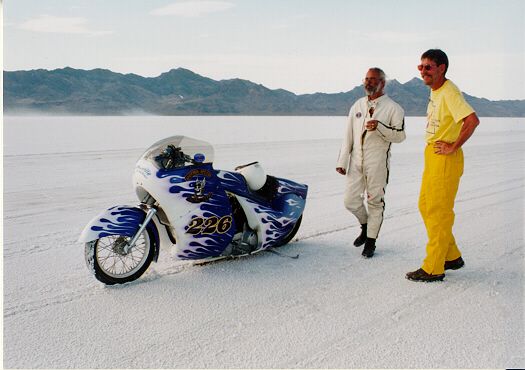
LSR stands for Land Speed Record and that means only one place...The Bonneville Salt Flats, the Great White Dyno. We have the only gas powered street legal bikes over 200 mph and we're damn proud of it. RB Racing doesn't race typewriters, we race motorcycles and when someone says they get a 70% gain from their system, ask them for their 200mph Bonneville Records or any records for that matter. Hell, if we raced typewriters it sure would be a lot easier, not to mention cheaper.
The technology we use with our turbos equally applies to our exhaust systems. Turbos don't make more power with excessive exhaust backpressure and normally aspirated exhausts don't like restrictive mufflers either. These are just antiquated 100 year old air compressors and they need all the help they can get.

We place an LSR tag on each exhaust system we
make so they can be easily identified. Every now and then over
the last twenty plus years someone decides to copy one of our
designs, usually because some customer is very happy and he
"stirs up the pond". They copy the general look but not the
features that make them work. The tags eliminate any question
about whether it's an RB Racing design or not and allows
people admiring your bike to know the pipe's origin.
The tags have proven to be very popular and have been used since 1992. Every now and then someone asks us to not place the tag on their system to which we answer..."send us an affidavit certifying that you have removed all manufacturer logos from your tires, engraved Performance Machine logos from your brakes, Mikuni or S&S identifications from your castings, Harley identifications from your gas tank, Nike logos from your tennis shoes etc. and we'll consider it". The last guy we let talk us out of this was getting his bike in Hot Bike magazine and said he'd give us "credit" for a one-off pipe we designed. When the magazine appeared on the newsstand all we saw was "computer designed pipe by Sands Racing". That was the end of that.
New Cloisonne Tags
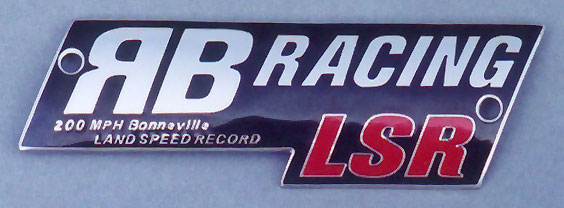
Like in the adage "The relentless search for perfection" we have upgraded the logos we put on our LSR Exhaust Systems. Previous tags were stamped and formed aluminum with silkscreened details. The new cloisonne tags are a precision die struck brass, nickel plated, with powdered glass fired in an oven then polished to a jewelry finish. These are direct replacements for our older tags and are available for US $25.00 postpaid via US Global Express (foreign) or Priority Mail (domestic US). They come with black headed rivets and are riveted in place with a light coat of high temperature silicone (Permatex 598B) behind the tag.
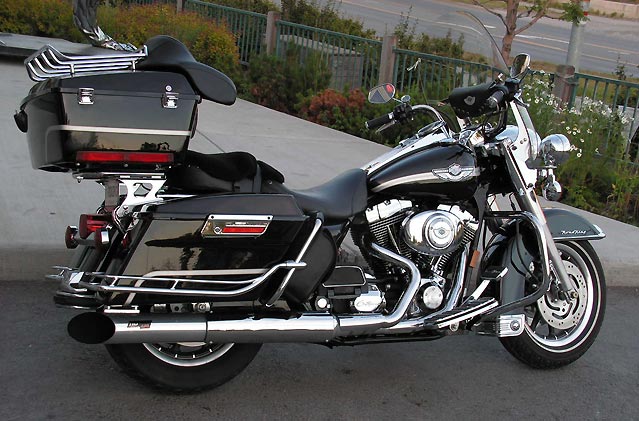
All RB Racing LSR Exhaust Systems feature our "new" (we've been quietly doing it since 1985!) CNC machined Turbo Venturis that actually "scavenge" to help your motor breathe. Machined from billet, these allow full 2" flow and eliminate the phony restrictions that other 1 3/4" to 2 1/4" pipes have at your exhaust port. We supply special close tolerance aircraft nuts for your exhaust studs because our machined venturis are too wide for a standard hex nut. Turbo venturis have also been machined for the large port, 4 bolt flange, S&S "SA" and newer B-2 heads (see bottom of page).
All the way from Alaska...00-1236 LSR 2-1 Black Hole.
Performance Built In...Exactly, For Each Application
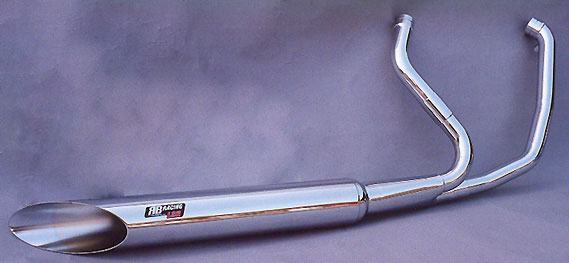
Our competitors must think you won't notice that
they neck their 1 3/4" to 2 1/4" pipes down to as small as 1
1/2" to mate them to your exhaust ports. RB Racing's Turbo
Venturies are expertly heliarced to each primary tube
eliminating any internal obstuctions and insuring the maximum
flow from each exhaust port. RB Racing won't build phony
performance pipes...We sure as hell won't ask you to port your
heads, put in bigger valves and a high performance camshaft then
stick a bunch of stainless steel discs or machined aluminum butt
plugs in the pipe to restrict the flow!
And we damn sure won't put some silly "1950-ish" reverse megaphone pipe with internal flat plates, baffles and air foils to screw up your performance. Our pipes make anywhere from 6 to 18HP over these stupid designs. From the Turbo-Venturies to the exit of the pipe our pipes outflow all other pipes on the market. Pictured above is a 00-1261 LSR Black Hole 2-1 for a Dyna TC88, Style C, 1 3/4" shown without heat shields.
For those of you who bought the slip in "torque cones"....Throw them in the trash.
Dynas
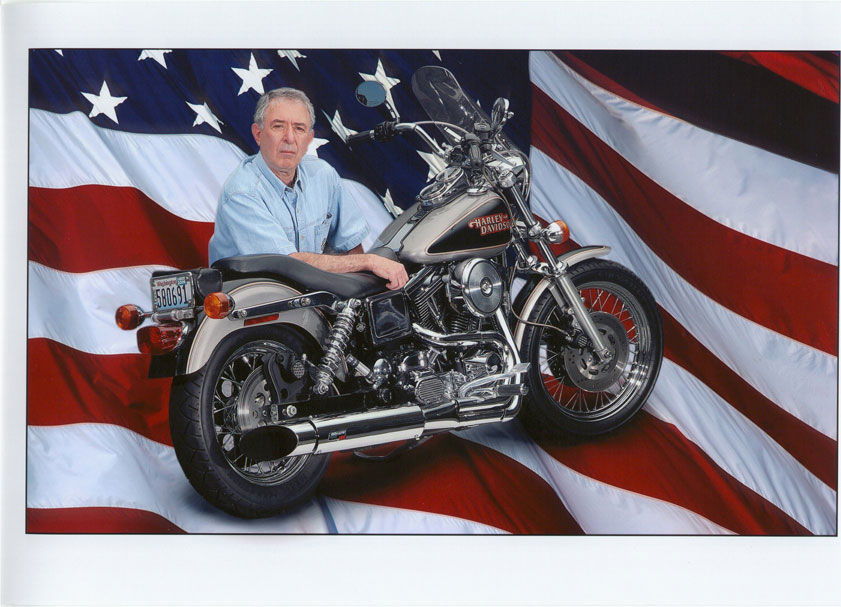
B Style, 1 3/4" Dyna LSR 2-1 Black Hole on a 1997 Dyna Glide part number 00-1159. No flags touched the ground. No flags were walked on.
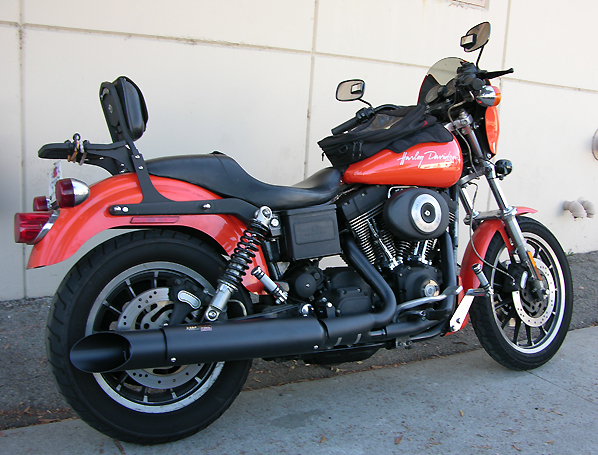
We build both 1 3/4" and 2" primary tube designs to handle both stock and big inch engines. The borderline seems to be at about 95" where you can step up to a 2" primary design. There are exceptions to this and it's decided on case by case basis depending on how the motor is set up and how you use your bike.
Pictured above is a Dyna TC88 (Pre 2006) with a 00-1260 LSR 2-1 Black Hole, 1 3/4" primaries in black ceramic with black ceramic heat shields. This one shows up in those dangerous venues where Hollywood screenwriters tread. Walk into meetings in biker gear and prepare to do battle. Go Warren!
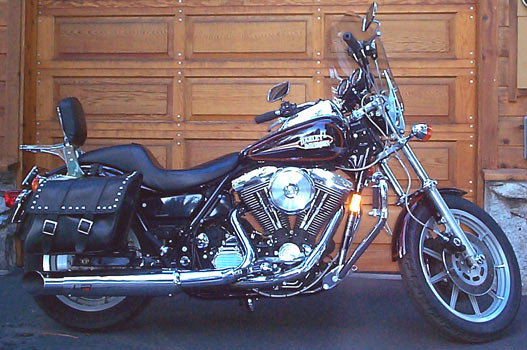
FXR Customer from Washington comments: " I have been out riding the last few days during our usual warm Spring days, the Black Hole exhaust is terrific. Performance continues to impress while the sound is a symphony to my ears, mellow but not loud. I love the pipe!". 00-1021 LSR 2-1 Black Hole, 1 3/4", C Style, in chrome.
DYNA Customer comments: "It's so quiet I can talk to my wife while we are on the highway."
SOFTAIL Customer writes "I installed the pipes I ordered on my stock F.I. Softail Deuce. They look great, sound superb, and there was a 17.8% horsepower increase and a 8.6 torque increase. The increases started about 3,000 rpm and continued to past 5,500. I am very pleased."
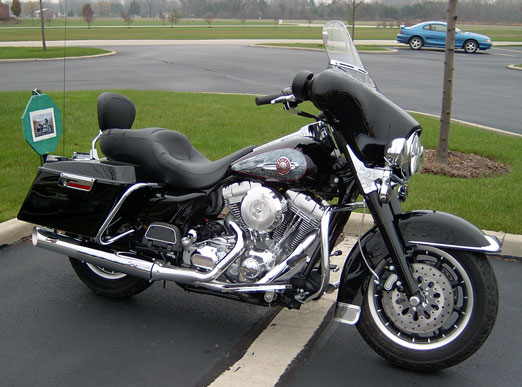
FLHT Customer writes " I ride so much faster now because I don't attract any attention. I also raced another bike and the other guy got yelled at for making too much noise...no one said boo to me".
Our CNC machined Turbo Venturis are not compatible with the "bowl-shaped" late model OEM exhaust port gaskets and require early style "flat" gaskets for the LSR Exhaust Systems to both fit and seal properly. The narrow machined flat face of the Turbo Venturi must seat against a flat surface, not the bowl-shaped late model gaskets. Using the LSR Exhausts in combination with the wrong gasket will cause misalignment, inability to tighten the provided close tolerance aircraft nuts, and will force the bowl-shaped gasket into the exhaust port. The correct woven style gaskets to use are: Harley OEM 65324-83 or Drag Specialties DS 174742.
Customers have asked us to include our billet gaskets with each LSR exhaust system as it is a hassle to search for the correct flat woven, early style gaskets and they cost the same as our superior billet gaskets.
Mandatory for a nominal charge of $9.95 are
a pair of our LSR CNC machined gaskets which mate perfectly with
our Turbo Venturies. These are proven in over 16 years of use on
our race and turbo applications...the only gaskets that will
stay in a turbo bike for 25,000 miles! These gaskets prevent any
gasket "creep" into the exhaust flow and are one more thing that
will give you "an edge" on the competition.
We always wondered why people would port their heads, put in bigger valves and then squish the gaskets into their exhaust ports. We bet you never paid attention to what was going inside your exhaust ports for one very simple reason...you can't see what's going on in there once the pipe is tightened! The LSR CNC machined gaskets also insure perfect alignment of the exhaust system. Most fitment and alignment problems are traced to using either the wrong type of gasket or using old gaskets that have taken a "set". We've always used these on our race applications and it's time everyone who's concerned about performance should do the same.
Goo

RB Racing LSR 2-1 exhaust systems use either one or two slip joints depending on the model. We suggest you put a coating of Permatex 598B ULTRA BLACK in the slip joint. None of our slip joints use any clamps because then they wouldn't be slip joints anymore. The inner pipe gets hotter that the outer pipe and they grow into each other and form a tight seal. The 598B is a non hardening gasket material and will prevent any leakage from condensation that forms in the pipe and, with the usual carbon particles, will actually seal better over time. It also makes the pipes easy to take apart later on. Get a tube before you install your RB Racing exhaust system.
All LSR 2 into 1 exhausts require special close tolerance aircraft nuts to bolt the LSR Turbo Venturies to the exhaust port. Standard 5/16" x 24 hex nuts will not fit. Each exhaust comes with the required four nuts. It is recommended that you order an extra set (4) of these nuts, part number 00-1001, when you order your exhaust. The exception to this is the four bolt "SA" and B-2 flanges on the S&S Special Application cylinder heads which use Allen bolts.
All RB Racing LSR exhaust systems come standard with a machined and heliarced oxygen sensor boss just below your front exhaust port. This port is designed to accept and oxygen sensor (18mm x 1.5mm) which will allow you to use our RSR Air/Fuel Ratio Meter to tune and monitor in real-time your air/fuel ratio. Also, if you really wish to get 55mpg and kick ass, our RSR Fuel Injection's closed-loop heated O-Sensor will plug directly into this port.
In the case of OEM EFI either 18mm or 12mm O2
ports are standard. M8's have both. Twin Cams that came with
12mm also get 18mm at no charge.
Chrome, Ceramic Silver, or
Dual Coat Ceramic Black
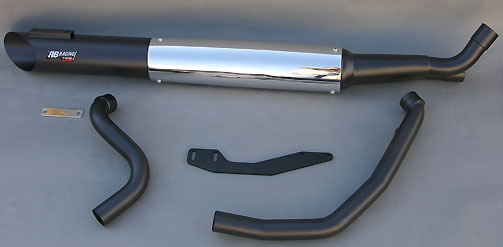
Chrome, Black Ceramic, or Silver Ceramic: All chrome is full automotive grade duplex nickel, triple plate; Black Ceramic finishes have a semi-gloss black look. Silver Ceramic finishes have a polished surface finish. Black Ceramic or Silver Ceramic pipes are fully polished as if they were to be chromed to remove any surface defects, then are blasted, and finally ceramic coated. Picture above is a 00-1236 TC88 FLH, 1 3/4" C Style LSR 2-1 Black Hole Exhaust. The chrome heat shield is standard on all LSR 2-1 Black Hole systems.
Ceramic finishes hold the heat in the exhaust better than does chrome. Chrome has the hardest surface finish. Ceramics do not change color. Ceramics can scuff or marr if hard, sharp objects scratch them. Heat shields for the primary tubes and collector area are recommended for all applications to prevent any contact with the pipe's surface.
Newer Dual Coat Black Ceramic Finishes
We have a lot more people looking for durable ceramic finishes and we think we have the best finishes on the market. In the late 70's and early 80's we tried all sorts of coatings and paints and even used porcelain on some of our products in the late 1980's. The newer ceramic finishes are tougher and we use both Polished Silver, and Semi-Gloss Black, to complement our usual chrome offerings. The newest "Turbo" Black finishes are a dual coat process that gives additional protection against scratches and nicks, providing two barriers against corrosion.

In more than 3 decades we have tried all sorts of black finishes: Kal Gard, VHT, Techline, and others. We also in the mid 1980's we even tried porcelain for awhile. It chipped and the heat distorted the parts. Most finishes will not survive over a long period unless they have a base coat to cushion rock strikes and scratches. The surface has to be perfectly prepared and most applications can fail if run too soon at elevated temperatures as they are typically baked at 450 to 500 deg F whereas the cure takes place at around 750 deg F. Lower temperatures will not cure the resins and they will fail once the bike is run. To get around this dilemma we have found the best solution is a 2500 Deg F Silver Ceramic cushion base coat and a secondary Black Semi-Gloss finish on top of this.
Dual Coat Black Ceramic finishes are therefore the most expensive
as they involve a triple process. First the parts are polished
to remove any tooling marks.Then the parts are zirconia media
blasted to prepare the surface. Then parts are cleaned. The
parts are base coated with a 2500 Deg F Silver ceramic and
baked. The next day they are sprayed with Black Ceramic and
baked for a third time.

On our Dual Coat Black Ceramic LSR 2-1 Exhaust Systems the heat shields and heat shield clamps are ceramic coated with 2000 Degree F satin black ceramic finishes. These finishes resist carb cleaners and other chemicals.
On "C" Style pipes there are four shields: one on the rear pipe, one on the front pipe, one for the collector area, and one for the Black Hole muffler. Pictured above are the four shields on an 1 3/4" plus 10" LSR Black Hole 2-1 for a TC88 FLHT.
On "B" Style pipes there are five shields: Two on the rear pipe, one on the front pipe, one for the collector area, and one for the Black Hole muffler.
All Black Hole Exhausts have a chrome heat shield (mandatory) on the muffler section. This is where the exhaust energy is dissipated to muffle the sound. Cancelled energy generates or traps heat. If you are running at elevated RPMs under load for extended periods there can be some discoloration of the chrome in this area. The shield provides a heat barrier and decorative cover for this section of the muffler.
All primary tube and collector shields are hand-fitted and have sturdy internal clamp brackets that are helibrazed into place...not spot welded, which would break. The Black Hole muffler shield is held in place by four stainless steel button head fasteners.
Those of you who want black or silver ceramic coated shields on ceramic coated pipes the answer is that we only offer chrome shields for these pipes...the cost for coating the shields is more than doing an entire exhaust due to all of the special handling. Heat shields are only available in chrome. The chrome surface resists scuffing.
RB Racing LSR Black Hole 2-1 Exhaust systems
are available for S&S
Cycle Special Application "SA" and SAB1/ SAB2/ SAB3
heads with 2 inch diameter primaries. The standard SA exhaust
valve is a whopping 1.75" diameter with a special (non
standard) exhaust port configuration. Newer B-2 heads employ
1.800" exhaust valves. These are the best production castings
going with their raised inlet and exhaust ports.
Oh, you can fool around with the usual porting bullshit, but you'll end up where these castings start out in terms of cfm. Progress is progress and year to year the only horsepower gains come when you make the cylinder heads more efficient. The problem with the SA heads is that nothing fits their four bolt pattern and the shallow non-standard pocket is decidedly bigger than anything sitting on the shelf...stock flanges need not apply! S&S figures you are going to fab your own exhaust so they provide a machined spigot that slips through the four bolt flange. The idea is that you get some springs and make up a slip joint and go creative...this doesn't work on street chassis.
"SA" and B-2 Four Bolt Turbo Venturies
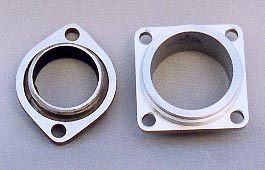
Compare the oem size exhaust flange on the left that is used on "billet" motors with the "SA" flange on the right...get out your calipers and see what's holding these other motors back. RB Racing is familiar with these four bolt critters as we use them in our 113" and 132" RSR Fuel Injected ORCA motors both turbo and normally aspirated. For our 113" and 132" ORCA motors we use cnc machined special Turbo Venturis that capture a laser cut four bolt flange and are in turn heliarced to our 2" LSR 2-1 primaries. The Turbo Venturis flow 8 to 12% more than a straight section pipe.
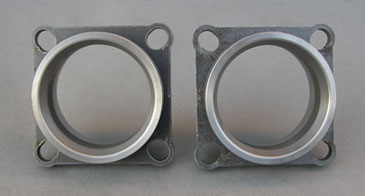
If you have a set of these "SA or B-2 Heads" and want a specific exhaust be sure to tell us at the time of your order. Adding an "SA" suffix to a listed part number will do the job. Remember they are only avaiable for LSR 2" primary designs.
S.T.D. Flanges for LSR 2-1 Black Hole Exhausts
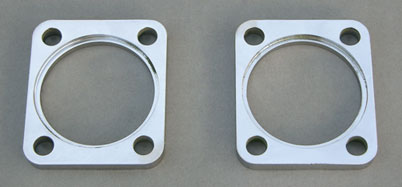
Dating way, way, back S.T.D. put four bolt or stud loctions in their cylinder heads. Lately they have been selling complete engines so we decided to make up some Four Bolt Flanges for our LSR 2-1 Turbo Venturis. These are available at the time you order your system for $29.95 per set in a chrome finish.
S&S 145" Tribute Exhausts Available
We custom make LSR 2-1 Black Hole Exhausts for the 1" taller 145" S&S Cycle Tribute motors (B2 4 bolt Flanges) that are designed for DYNA style transmissions (Ness Y2K or other frames). Specially machined Turbo Venturis, 2" primary tubes, square four bolt flanges (no gaskets). Part Number 00-1281, LSR 2-1 Black Hole for a 145" S&S Tribute motor pictured above. 2" primaries and three piece heat shield. Both front and rear pipes slip to prevent any failures and to allow for the higher deck height. Heat shield on tail section is standard on all Black Hole exhausts.
Purpose Built...No Porky Torkie or Thunder Crap
RB Racing flat-ass doesn't build things that don't work. There is a beauty in things that work well for their intended use and no one design is right for everybody. We build LSR 2-1 exhausts in both 1 3/4" and 2" varieties for everything from a stock EVO or TC88 right up to whatever big inch custom you can think of, including limited production Confederates, Bourgets and other aftermarket chassis. In addition, we make purpose built LSR 2-1 Pro Stock pipes that are the best flowing race pipe on the market.
The LSR Black Hole 2-1 fills another need...the need to have performance without the compromise of more noise. There is beauty in purpose and like the yacht or the plane..."If it looks right it is right". These are right.